I’ve spent the past decade exploring the national parks and there are few that I’ve spent more time in than Death Valley. Why? This place is endless and folks who tell you there isn’t much to do here or that it’s “meh” aren’t your friends. Death Valley spans over 5,000 square miles of otherworldly vistas and is the largest national park in the continental United States – there are endless amounts of things to do in Death Valley National Park.
Death Valley holds the record as the hottest place on earth, the record for the lowest place in North America, and the driest place in the United States. Driving from one end to the other takes nearly 5 hours.
All this to say, trust me when I tell you that there’s a plethora of amazing things to do in Death Valley National Park. Over the years this list of activities continues to grow as I find new gems worth mentioning here. I’ve included a mix of activities for everyone including families with small children, folks with mobility issues, and the more adventurous souls.

Things to Know Before Visiting Death Valley National Park
- Here’s my favorite guidebook & map for Death Valley.
- Lather up the non-toxic sunscreen.
Best Things to Do in Death Valley National Park
Table of Contents: Things to Do in Death Valley National Park
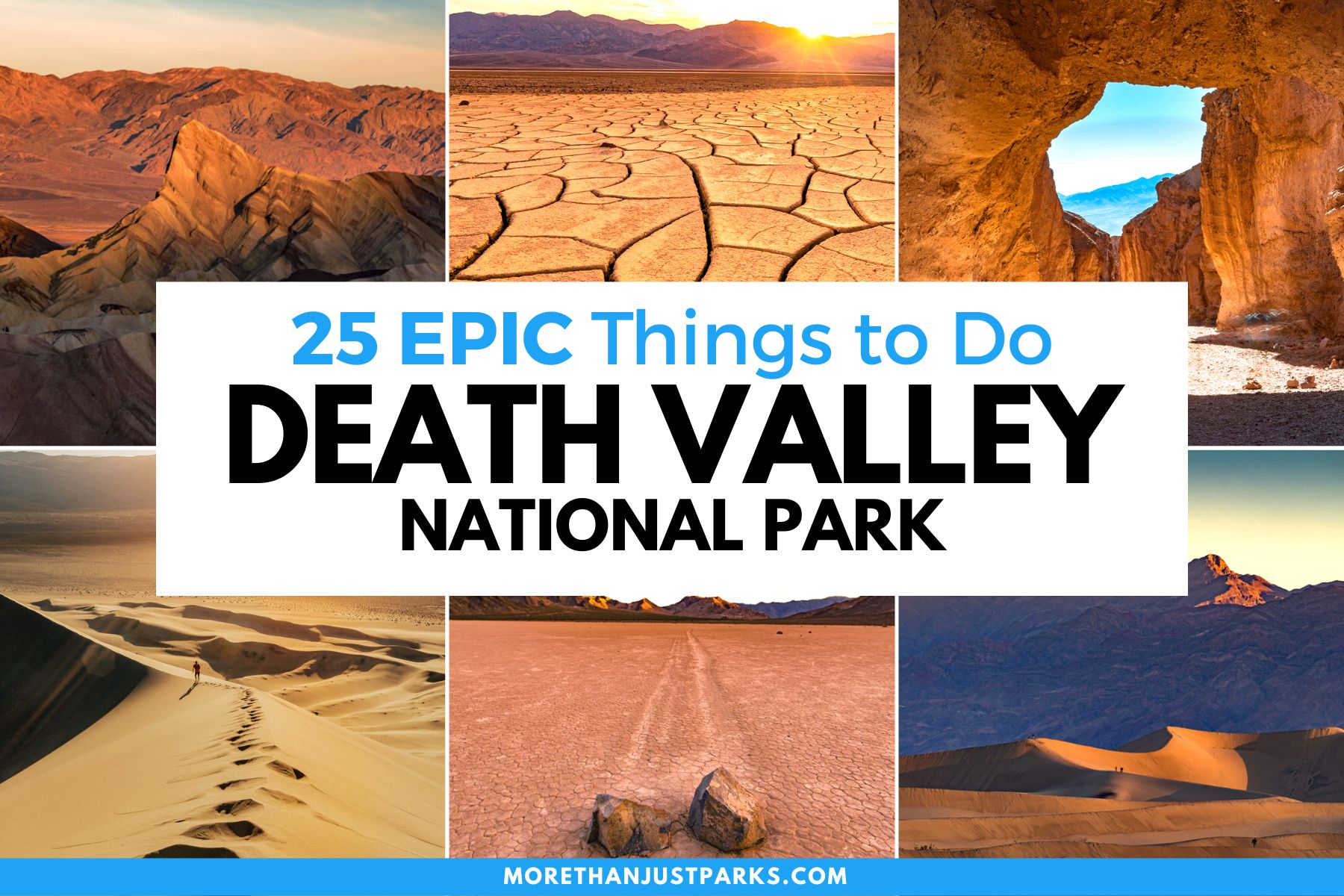
Table of Contents: Best Things to Do in Death Valley National Park
- Things to Know Before Visiting Death Valley National Park
- Best Things to Do in Death Valley National Park
- 1. Explore Eureka Dunes
- 2. Explore Badwater Basin
- 3. Sunrise from Zabriskie Point
- 4. Watch the Mysterious Rocks at Racetrack Playa
- 5. See the Kaleidoscopic Cliffs at Artists Palette
- 6. Play in Mesquite Flat Sand Dunes
- 7. Discover the Lee Flat Joshua Tree Forest
- 8. Gaze Upon Ubehebe Crater
- 9. See Darwin Falls
- 10. Sunrise at Aguereberry Point
- Top 20 Best Things to Do in Death Valley
- 11. Play a Round at the Devils Golf Course
- 12. Venture Across Ibex Dunes
- 13. Walk Under Natural Bridge
- 14. See the Wildrose Charcoal Kilns (by Night)
- 15. See Panamint Dunes (from afar)
- 16. Hike Through Surprise Canyon
- 17. Take a Scenic Drive
- 18. Ascend Telescope Peak
- 19. Marble Canyon
- 20. Explore Little Hebe Crater
- 21. Venture Out to Saline Valley Dunes
- 22. Find the Famous Death Valley Mud Cracks
- 23. Find Death Valley’s Elusive Burros
- 24. Find Abandoned Historical Remnants
- 25. Witness Sandstorms (from afar!)
- FAQ – Things to Do in Death Valley
- Map of Things to Do in Death Valley
- Summary of the Top 10 Things To Do in Death Valley National Park
- Visiting Death Valley National Park
- Death Valley National Park Map
Visiting Death Valley? Here’s my favorite hotel to stay in Death Valley National Park

1. Explore Eureka Dunes
Located in the remote Eureka Valley and situated at 3,000 feet elevation, Eureka Dunes is the most stunning dune field (of the five major dune fields) in the park. As such, exploring Eureka Dunes is easily one of the best things to do in Death Valley National Park.
Eureka Dunes are the tallest dunes in California and perhaps the tallest in North America. The tallest peaks reach a staggering 680 feet (207 meters). But what makes this dune field even more impressive is the jaw-dropping backdrop of the colossal Last Chance Mountains.
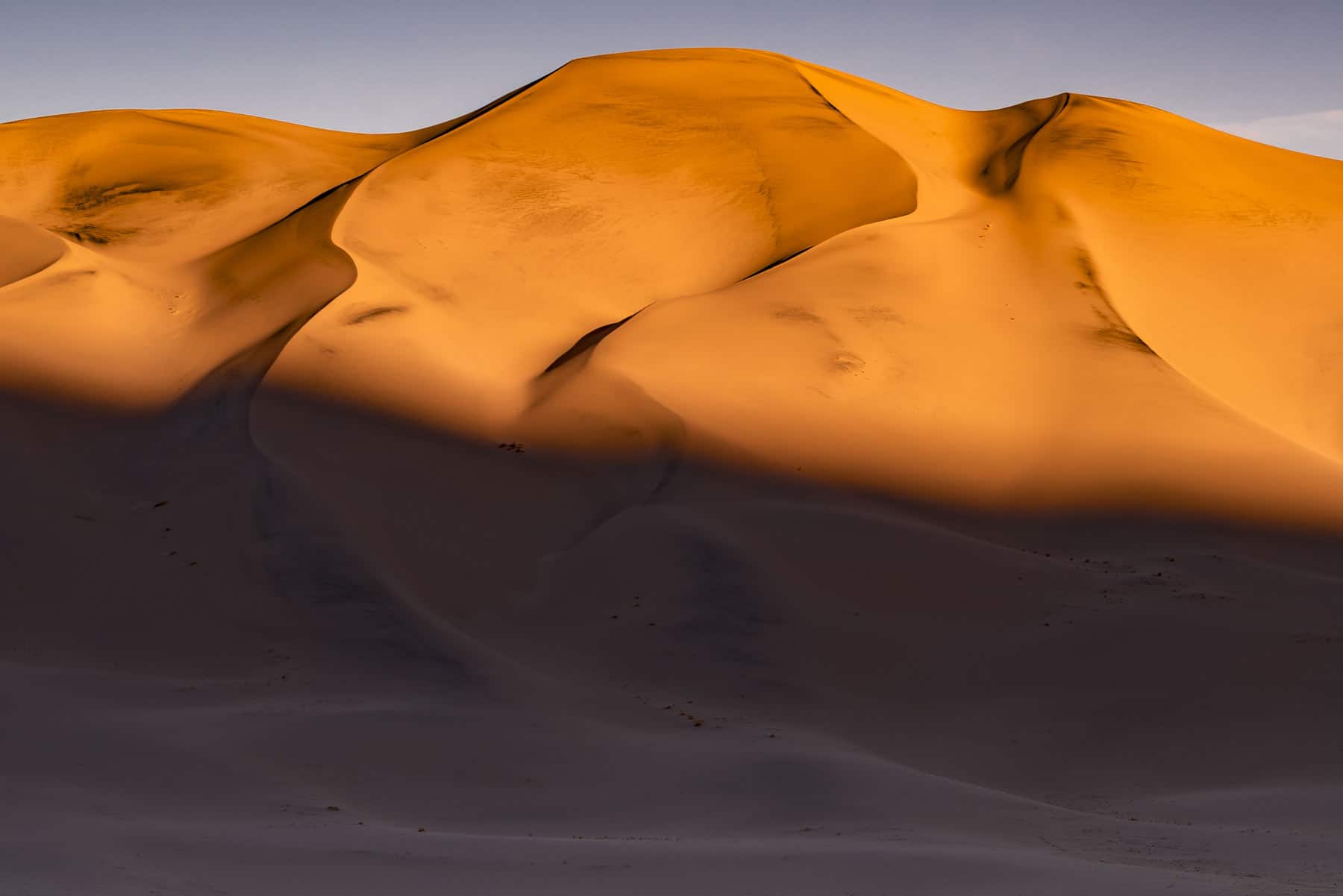
And if that wasn’t enough to entice you to visit, did I mention they sing? No, really. Eureka Dunes sing underneath your feet. The phenomenon has puzzled scientists for years but under the right conditions you’ll hear a bassy resonance resembling that of a pipe organ.
But take warning, these dunes are deceptively tall, and climbing them requires quite an effort. It’s a difficult challenge and can be downright dangerous during the summer months when temperatures are blazing.

However, of all the best things to do in Death Valley National Park, hiking Eureka Dunes is my personal favorite, which is why I listed it first. The view from atop the dunes is incredible and since they’re fairly remote, there’s rarely a crowd here. Worth noting, the Eureka Dunes Campground is a great spot to base camp if you’re lucky enough to score one of the seven primitive sites.
If you fall in love with dunes as I did, put Great Sand Dunes National Park on your bucket list.
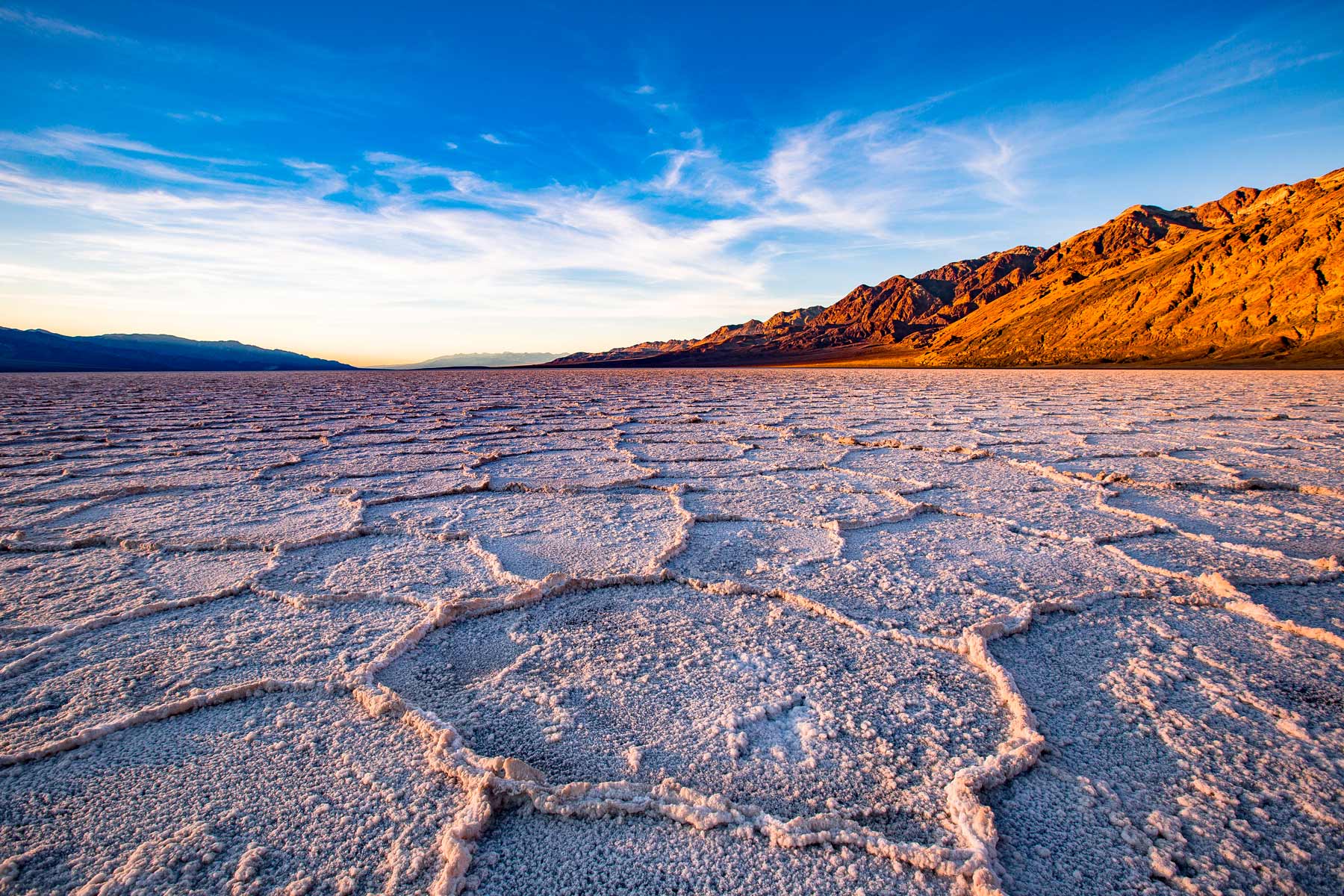
2. Explore Badwater Basin
At 282 feet below sea level, Badwater Basin is the lowest point in North America, reason alone to visit. This salty wonderland features dazzling geometric shapes and boasts record temperatures in the summer. This place is ripe for exploration and, thankfully, pretty easy to get to. Badwater Basin is one of the best things to do in Death Valley with kids as well as folks looking for convenient ADA activities.
Simply park your car at the Badwater Basin parking lot (get there early as parking is limited) and walk across a wooden boardwalk into the salt flats. Make sure to read the informative plaques at the start of the hike to learn more about the interesting lifeforms that have learned to thrive in this desolate landscape.
When you reach the salt flats, take your time admiring the fascinating jumble of geometric shapes that create this sea of salt. The further you go the more interesting the shapes get. Exploring Badwater Basin is one of the best things to do in Death Valley National Park because it’s so otherworldly – an experience you can’t get in many other places.
Tip: Most visitors just hike out a few steps beyond the short boardwalk but to truly get a sense of the scale of the salt flats one can do the entire 1.8-mile path.
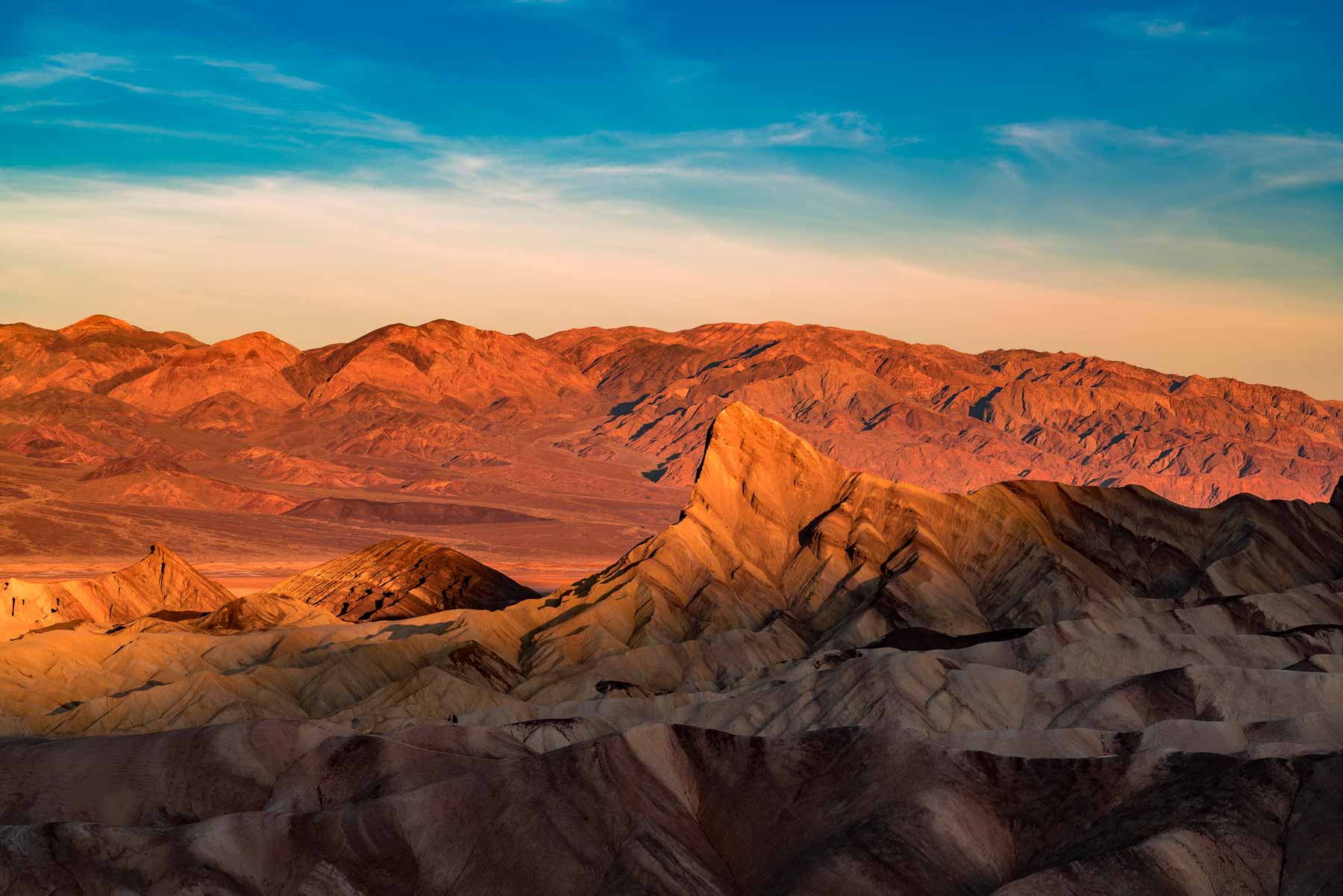
3. Sunrise from Zabriskie Point
Elevation: 5,744 feet (1,751 meters)
Watching a sunrise at Zabriskie Point is one of the most iconic things to do in all of Death Valley National Park. This location is my second favorite place in the park to watch a sunrise (more on that in a minute). The badlands below, formed by millions of years of erosion, showcase a mesmerizing palette of yellows, browns, and purples. The stark contrast between the colorful hills and the vastness of the salt flats in the distance creates a truly awe-inspiring scene.
As one of the Death Valley’s most popular locations crowds here can be quite large. Be sure to show up thirty minutes to an hour prior to sunrise to get a good spot! There is a short, steep paved pathway that takes visitors from the parking lot to the viewpoint making this one of the best things to do in Death Valley National Park for folks with ADA needs.
Fun Fact: The point is named after Christian Brevoort Zabriskie, a vice president of the Pacific Coast Borax Company who supported Death Valley preservation efforts
NOTE: Zabriskie Point is located at a much higher elevation than the valley floor so depending on the time of year you may want to bring a jacket.
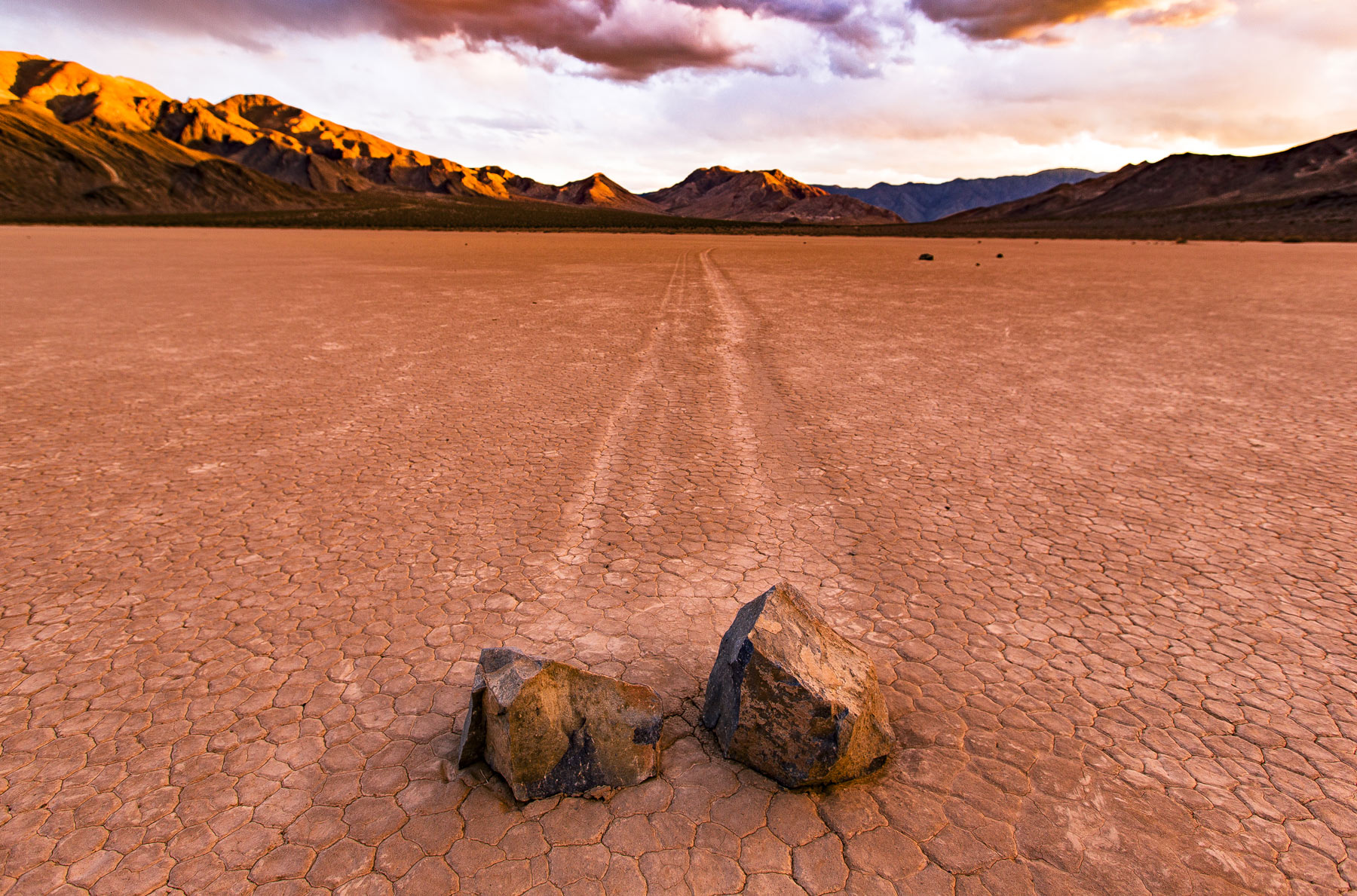
4. Watch the Mysterious Rocks at Racetrack Playa
The Racetrack Playa features rocks that mysteriously move across the cracked desert floor leaving long trails and lots of intrigue. This was at the top of my list of things to do in Death Valley for a long time.
The playa is really amazing, but its defining feature has to be the unique collection of rocks varying in size from a few pounds to hundreds of pounds, that have mysteriously moved across the surface over time leaving distinct trails in their wake. These trails can extend for hundreds of feet! The reason for this movement has long been a mystery, with many theories proposed, including wind, ice, and even algae mats. In recent years, researchers are pretty certain that the movement comes from a combination of factors, including rare flooding events and thin ice sheets.
If you are planning to go the Racetrack Playa I highly recommend a high clearance vehicle as the road is pretty rough. Make sure to pack plenty of sunscreen, water, & snacks as the closest services are a minimum 2-3 hour drive from the Racetrack Playa.
Damage to Racetrack Playa
This location is special and sadly has not always been treated as such. In recent years incidents have occurred with park visitors driving vehicles on the Racetrack Playa. Despite extensive efforts to repair the damage done the scars are still visible and will be for many years to come.
DO NOT drive off marked roads here or anywhere else in the park. If you see someone doing so be sure to take photos, record their license plate number, and file a report at the closest ranger station.
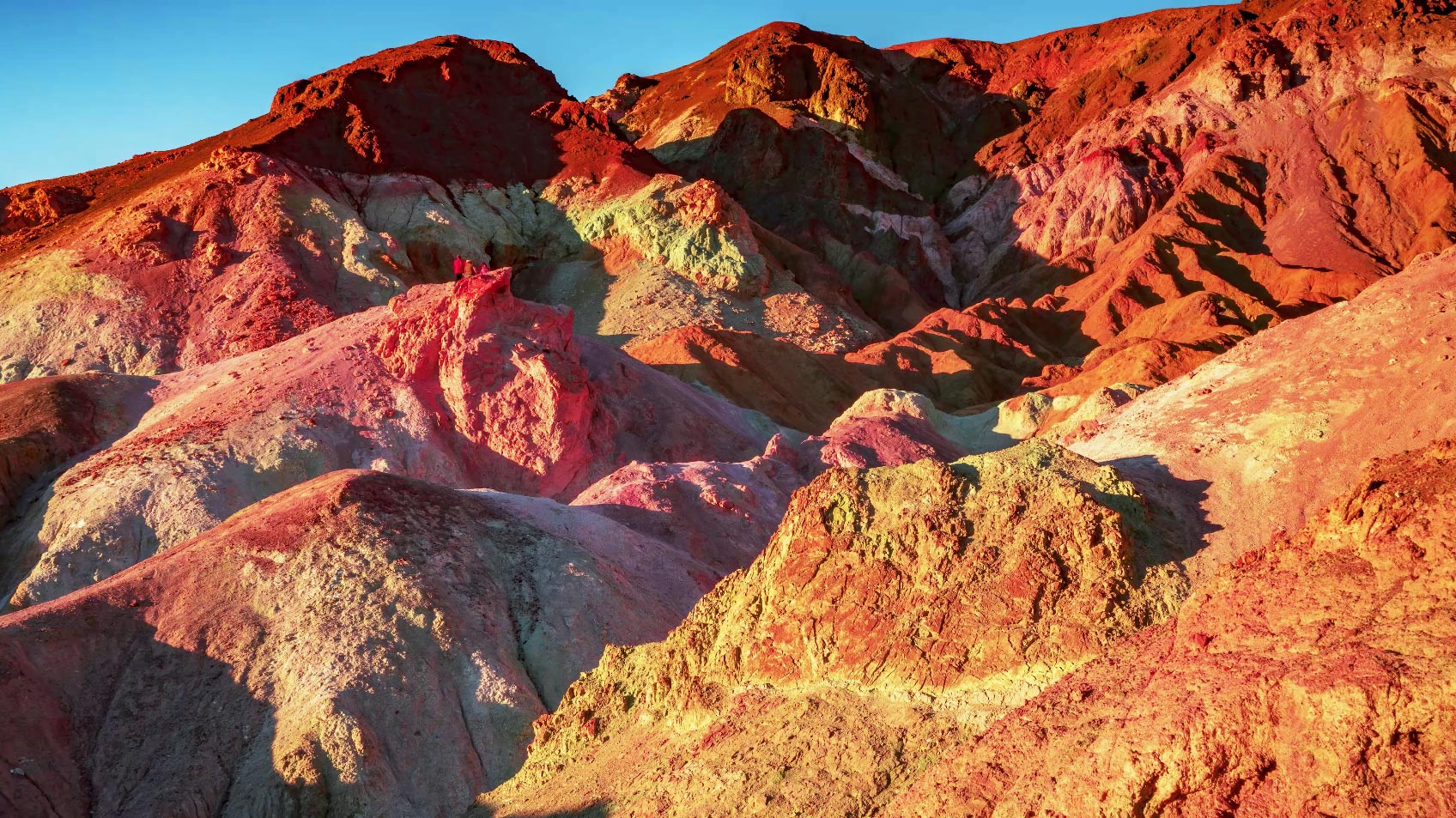
5. See the Kaleidoscopic Cliffs at Artists Palette
When I first saw photos of Artists Palette I thought it must be a case of Photoshop – surely the cliffs don’t actually look like that in person, right? Wrong. They do. But not at all times of day. Artists Palette is a technicolor, kaleidoscopic display of multicolored rock in Death Valley National Park that must be seen to be believed.
The vibrant colors of the Artist’s Palette are caused by the oxidation of different metals in the rock. Iron oxides produce reds, pinks, and yellows, while manganese minerals create lavender and purple hues. The decomposition of tuff-derived mica adds green tones to the palette. This unique combination of colors creates a mesmerizing and otherworldly landscape.
Located near the hub of Furnace Creek, Artists Palette is one of the most photographed spots in Death Valley. The colorful colors visible in the soil are the result of the presence of rich metals and minerals.
The best time to visit Artists Palette is in the evening when temperatures are cooler and the sun hits the rocks just so to really make their colors pop. Harsh midday sun mutes the vivid colors and should be avoided if possible. Alternatively the rare cloudy day makes for great photos at Artists Palette.
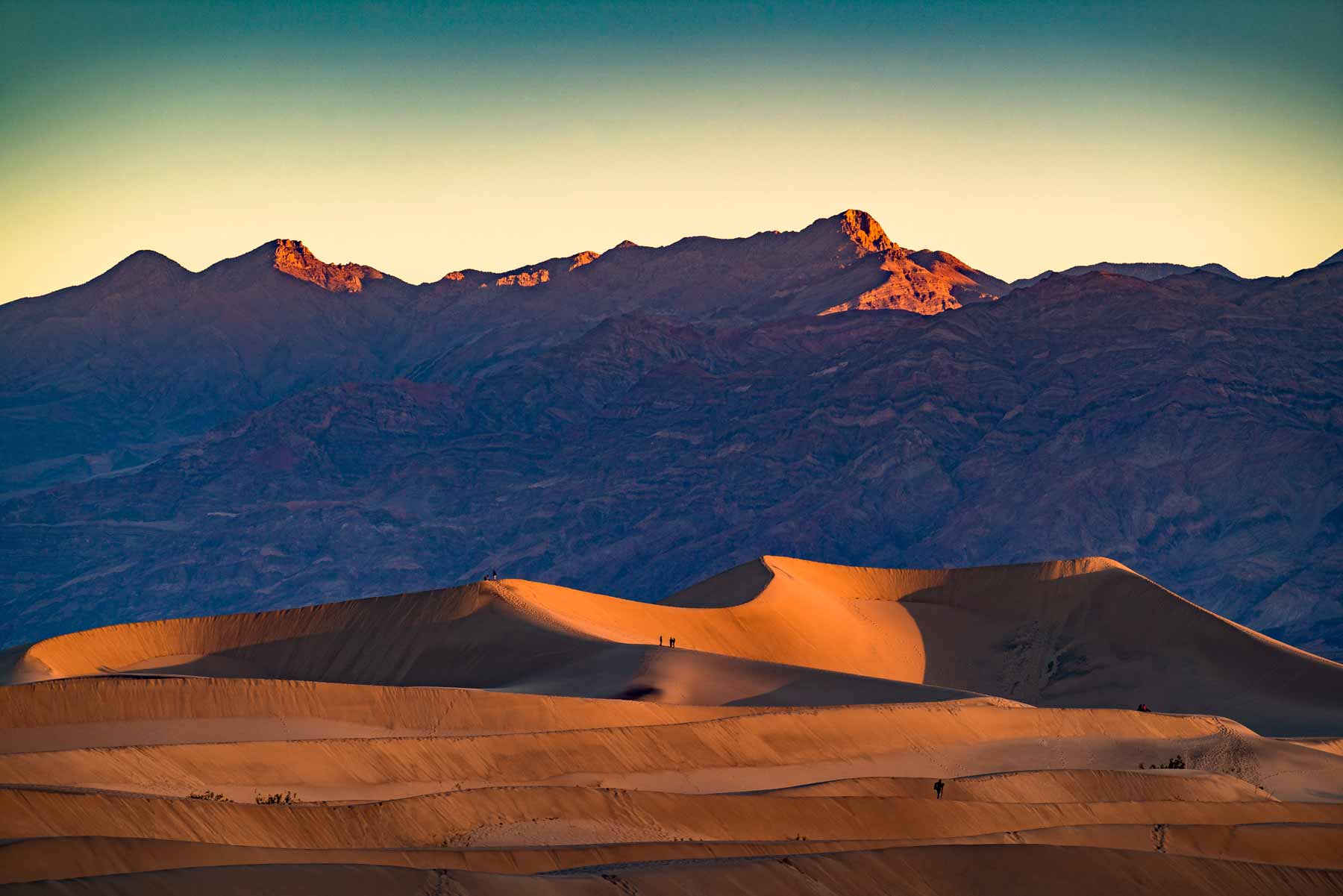
6. Play in Mesquite Flat Sand Dunes
Visiting Mesquite Flat Sand Dunes is on just about everyone’s list of things to do in Death Valley National Park so expect crowds! Don’t let that deter you though. Mesquite Flat Sand Dunes is the most popular of the five dune fields located in the national park and totally worth a visit. Seemingly endless golden dunes roll off toward the horizon with a backdrop of purple mountain majesty.
While not the tallest dunes in Death Valley, Mesquite Dunes cover a vast area, spanning over 40 square miles. This translates to a massive playground for exploration and activities. The tallest dunes reach around 400 feet (122 meters), offering impressive, panoramic views from the summit.
Located next to Stovepipe Wells village, Mesquite Flat Sand Dunes is an easy stop and a must-see for anyone visiting Death Valley. Make sure to layer up with sunscreen before hiking onto the dunes and bring plenty of water. There is no natural cover from the sun and the sand can be extremely hot to the touch so wear sandals during the day.
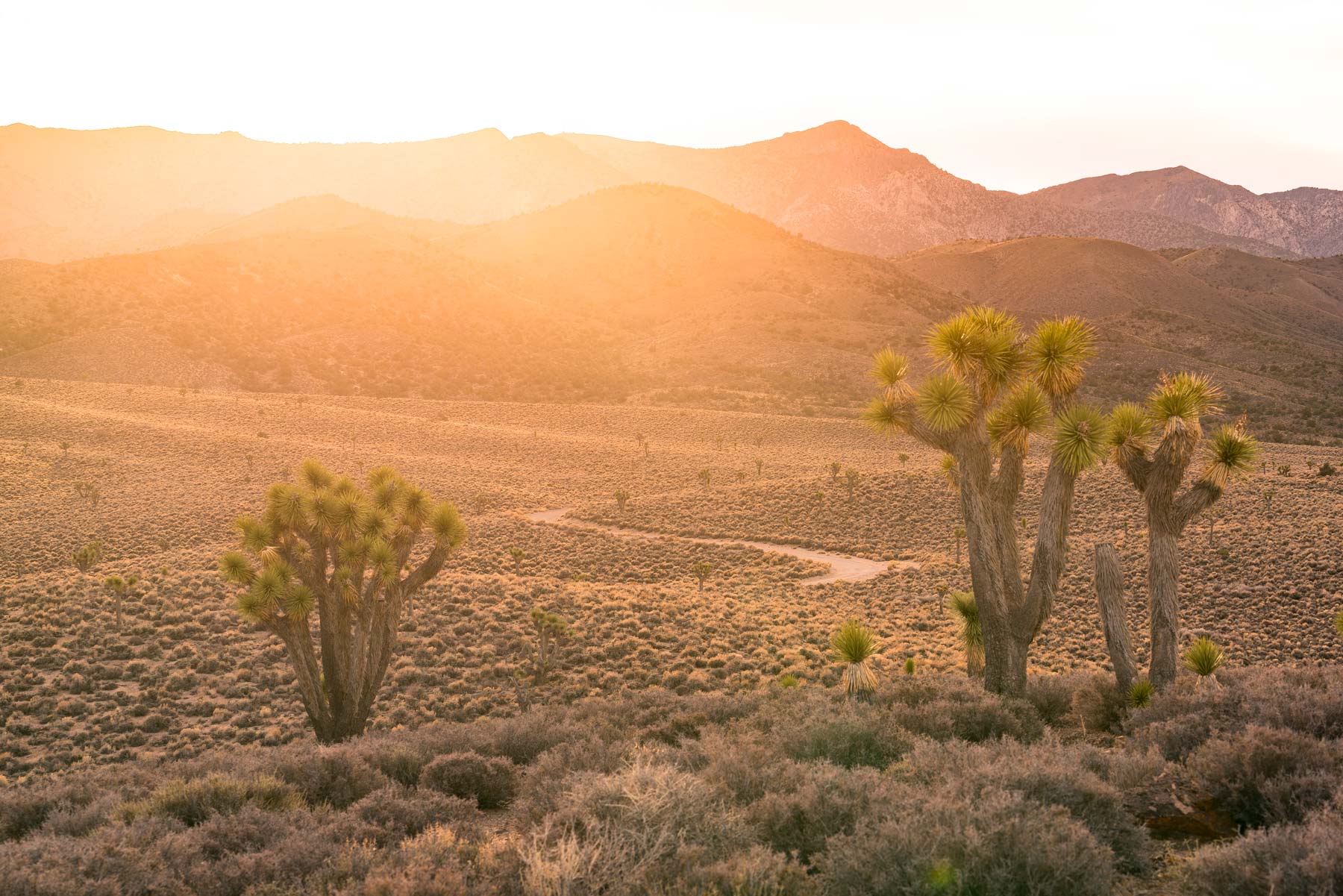
7. Discover the Lee Flat Joshua Tree Forest
If you’re like me and figured you had to go to Joshua Tree National Park to see Joshua Trees, well, you don’t. It turns out Death Valley has massive Joshua Tree forests and perhaps none as large as the Lee Flat Joshua Tree Forest located near the west entrance to the park. Visiting Lee Flat is one of the best things to do in Death Valley for folks looking to escape the crowds. I’ve visited numerous times and typically have the entire place to myself.
Lee Flat is situated at a much higher elevation than the valley floor and as such has a very different feel. Temperatures can be 20 or more degrees cooler here from what visitors find at Badwater Basin. Sunset is an especially beautiful time to visit this area to watch the light turn colors and sweep across this vast landscape.
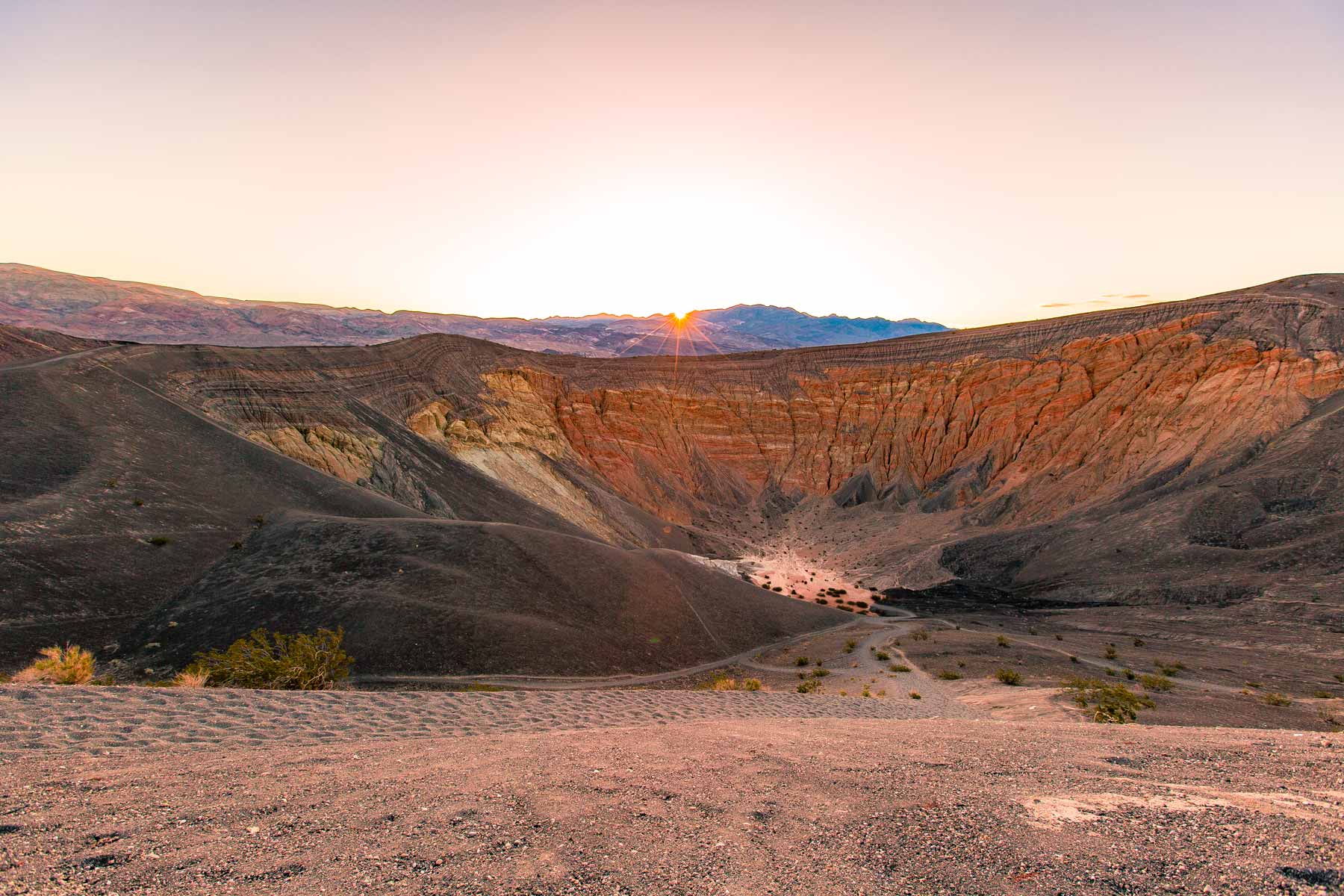
8. Gaze Upon Ubehebe Crater
Ubehebe Crater, pronounced “YOU-BE-HE-BE”, was not created by a meteor strike but rather volcanic activity. Located toward the northern end of the park near Scotty’s Castle, this site is a great Death Valley activity for families with kids.
Ubehebe is a half-mile wide behemoth, formed by a phreatic explosion (molten lava meeting groundwater) and boasts vibrant hues of reds and oranges in its exposed layers. Hike the rim for panoramic views or venture down (prepare for a challenging climb back!) to feel the crater’s immensity.
- Distance: 2.2 miles roundtrip
- Time: 1-2 hours
Make sure to visit Little Ubehebe Crater (more on that below) while stopping by as many visitors (including myself) find it more photogenic and stunning than its larger namesake.
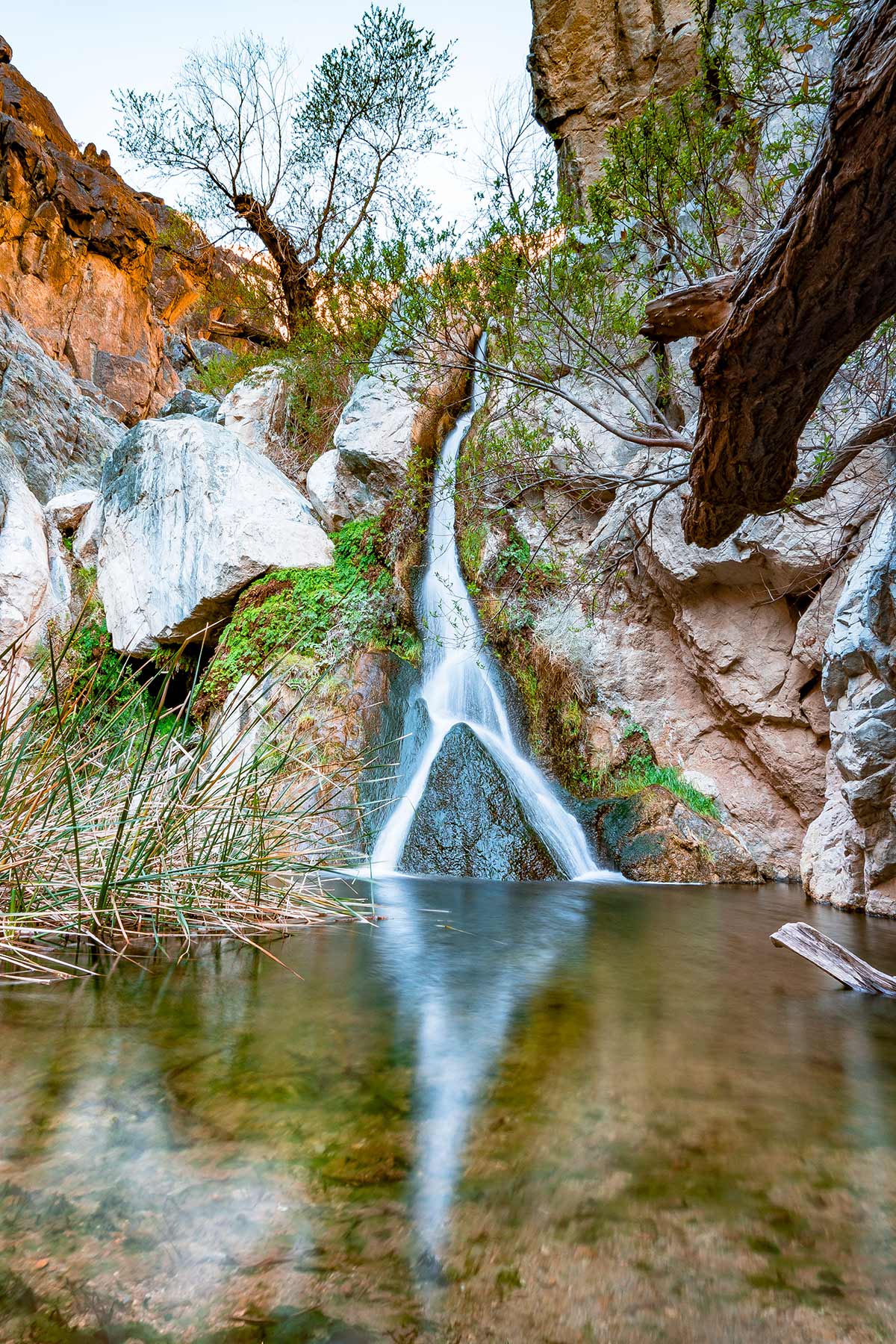
9. See Darwin Falls
Darwin Falls is a great addition to your list of things to do in Death Valley just for the sheer improbability of a waterfall existing here! When I first heard there was a year-round waterfall in Death Valley National Park I thought it was too good to be true too.
The main attraction is a series of cascading waterfalls, with the upper falls reaching about 75 feet and the lower falls around 20 feet. These falls plunge into a crystal-clear pool, creating a picture-perfect scene. The spring-fed water nourishes a vibrant landscape of trees, ferns, cattails, and other greenery, contrasting starkly with the surrounding desert terrain.
The trailhead to this waterfall starts just down the road from the Panamint Springs area of the park. The whole way in keeps the suspense alive as to whether there is actually any water to be seen in the hottest place on earth. Shortly down the trail, however, a creek appears and the suspense builds. Seemingly out of nowhere, song birds start singing, crickets start chirping, dragonflies begin buzzing, and even frogs start to croak!
- Distance: 1.9 miles round trip
- Time: 1-2 hours
Looking down at what started as a tiny sliver of water one realizes that they are looking at a full-blown creek now. And then it’s there – Darwin Falls in all her beauty. I highly recommend this hike to everyone visiting the park as a great way to refresh, cool off, and witness a desert miracle firsthand.

10. Sunrise at Aguereberry Point
If you’re looking to beat the crowds at sunrise then add Aguerberry Point to your list of things to do at Death Valley National Park. While the most popular sunrise spot in Death Valley is Zabriskie Point, if you want to see the most spectacular (says me) sunrise in the park you’ll have to cross the valley and view it from the other side at Aguereberry Point.
Perched at an elevation of 6,433 feet, Aguereberry Point offers stunning panoramic views of the vast desert landscape, comparable to the popular Dante’s View on the opposite side of the valley. The point is named after Jean Pierre “Pete” Aguereberry, a French miner who discovered gold nearby and lived in the area from 1905 until his death in 1945. The remnants of his cabin and the Eureka Mine, where he worked, can still be seen near the viewpoint.
Whereas Zabriskie & Dante’s face away from the sun, Aguereberry Point looks directly at it creating a more dazzling display of colors and light to usher in the day. Aguereberry is certainly more remote than the other points, and as a result, far less crowded. When I visited we were the only ones there versus Zabriskie which is always packed. Also, visitors can drive right up to the point without a hike.
Top 20 Best Things to Do in Death Valley
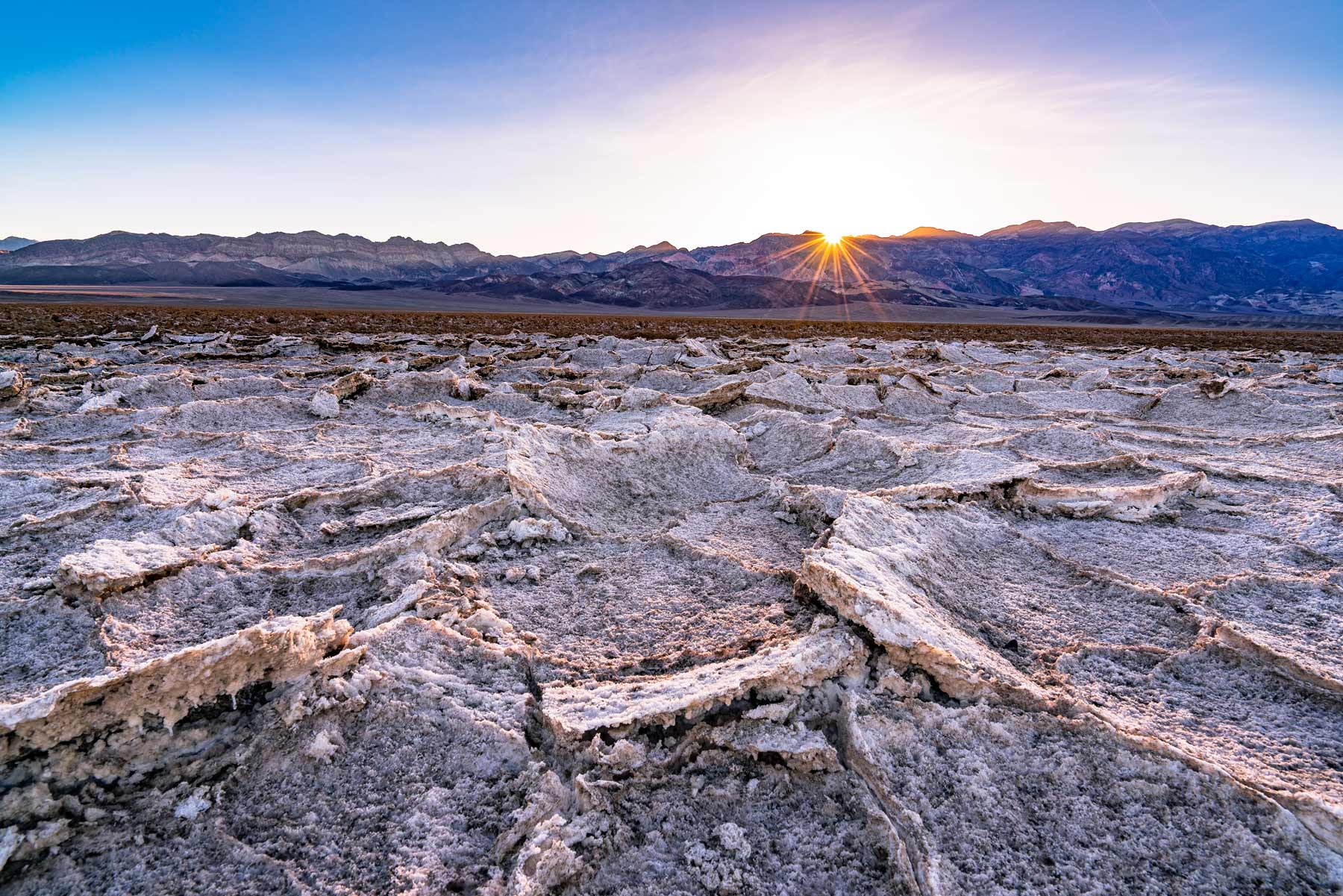
11. Play a Round at the Devils Golf Course
Death Valley National Park is the king of things with morbid and foreboding names, like Devils Golf Course. Devils Golf Course is many park-goers’ favorite spot in the whole park. The name “Devils Golf Course” comes from a 1934 National Park Service guidebook that described the terrain as so uneven and treacherous that “only the devil could play golf on it.”
The entire area is covered in large, crystallized halite salt formations, the remnants of an ancient lake bed that dried up thousands of years ago. These salt formations are constantly being eroded by wind and rain, creating new and ever-changing shapes.
NOTE: The salt formations are delicate and can be easily damaged by human touch. It’s important to stay on the designated trails and avoid walking on the salt crystals.
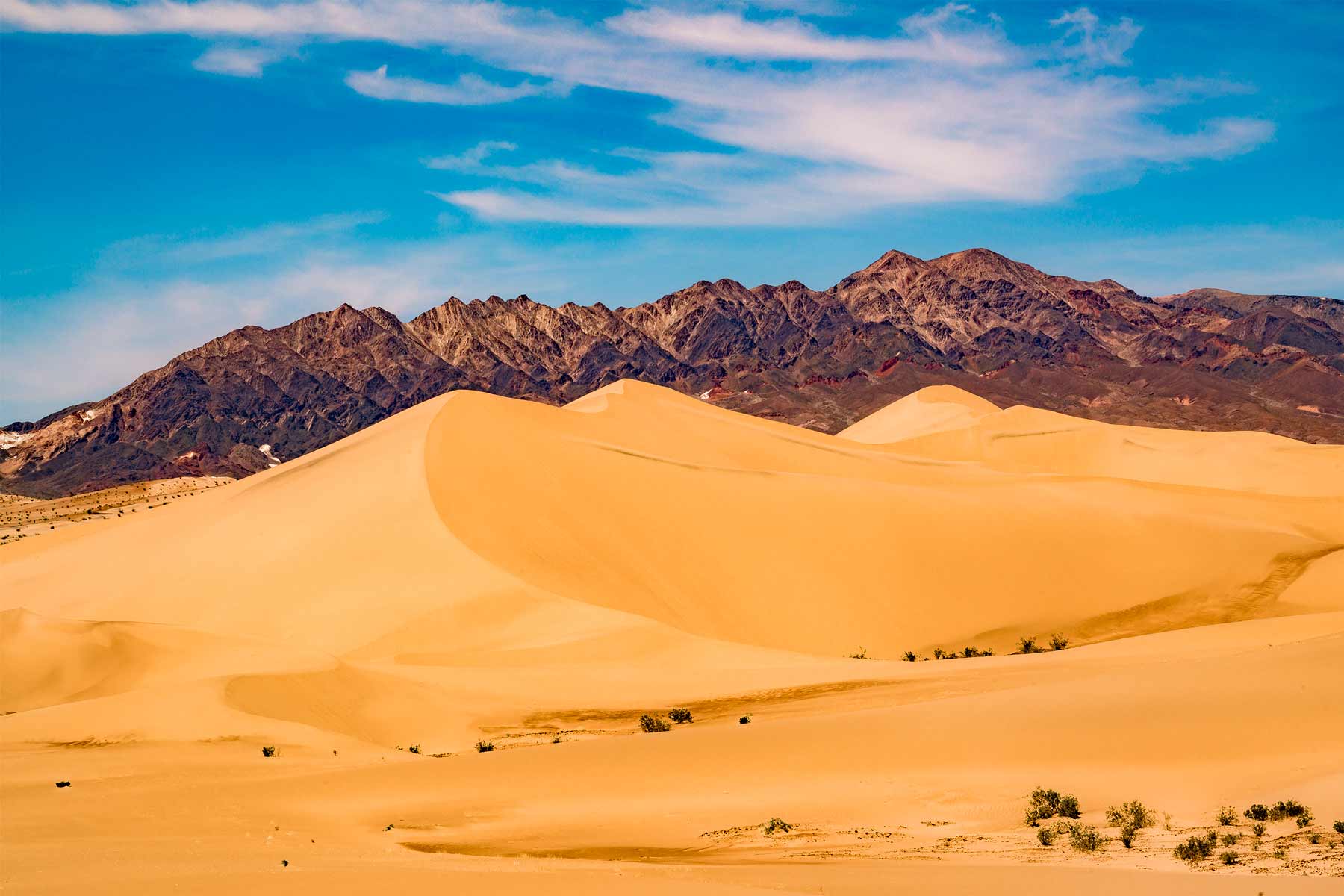
12. Venture Across Ibex Dunes
If you’ve got a few days to explore then I highly recommend adding Ibex Dunes to your list of things to do in Death Valley National Park. Ibex Dunes are perhaps the most photogenic dunes in the park (right up there with Eureka Dunes) and almost as remote. These dunes are located on the southern end of the park off of a rough, high-clearance road.
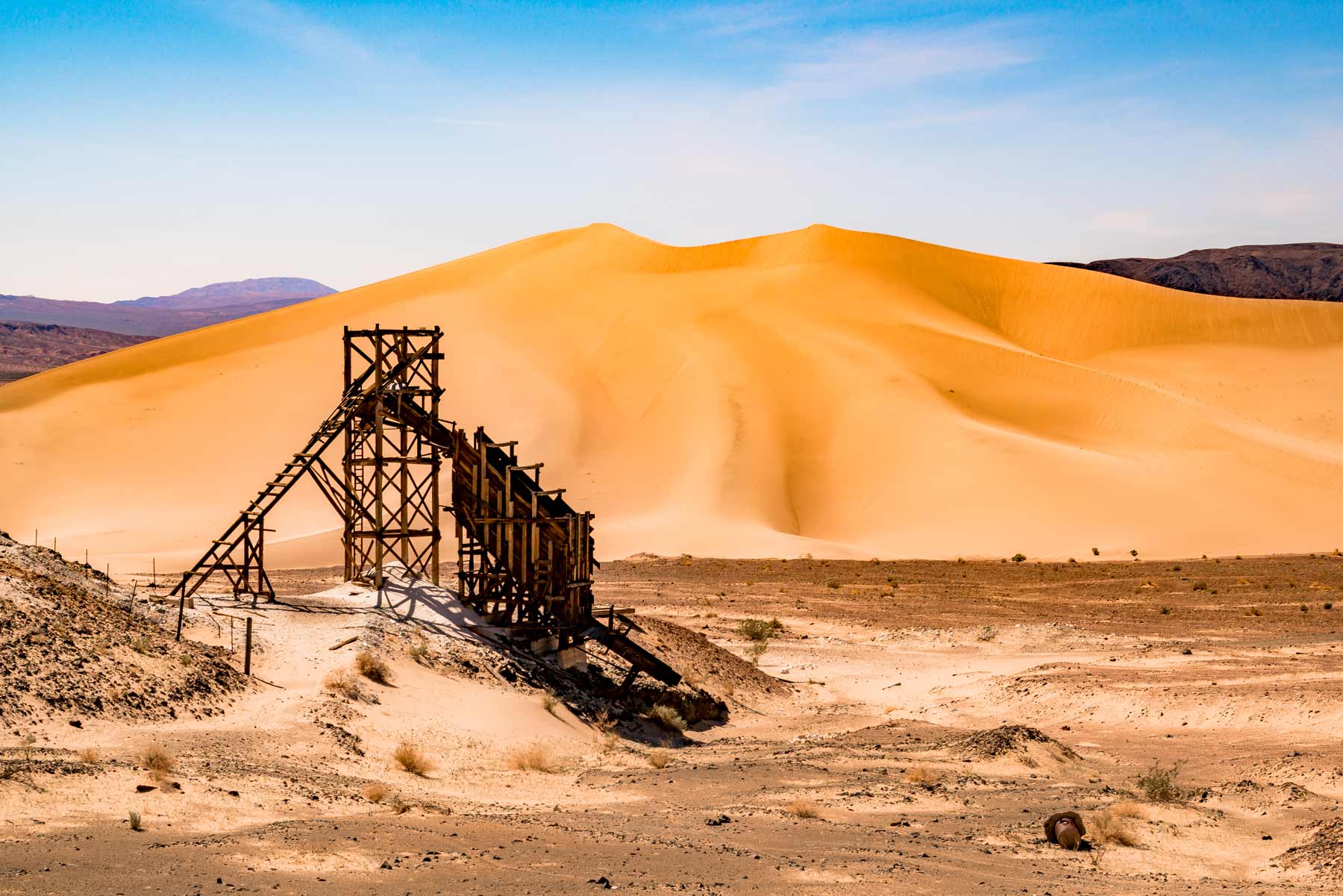
Ibex Dunes are a blast to explore but make sure to do so early as they heat up fast, even in winter, and can create dangerous situations for hikers. One of the coolest parts of exploring Ibex Dunes is finding the abandoned mine on the far side set against the mountains. This eerie spot is a remnant of a bygone era and makes for a great photo opportunity. If you plan on hiking across the dunes be sure to pack way more water than you think you’ll need along with a sun hat, and snack to re-energize!
As you explore the warm sand, keep an eye out for Ibex Spring, a small oasis nestled on the eastern slope of the hills. This hidden gem is complete palm trees and a small pool of water, a stark contrast to the surrounding aridity.
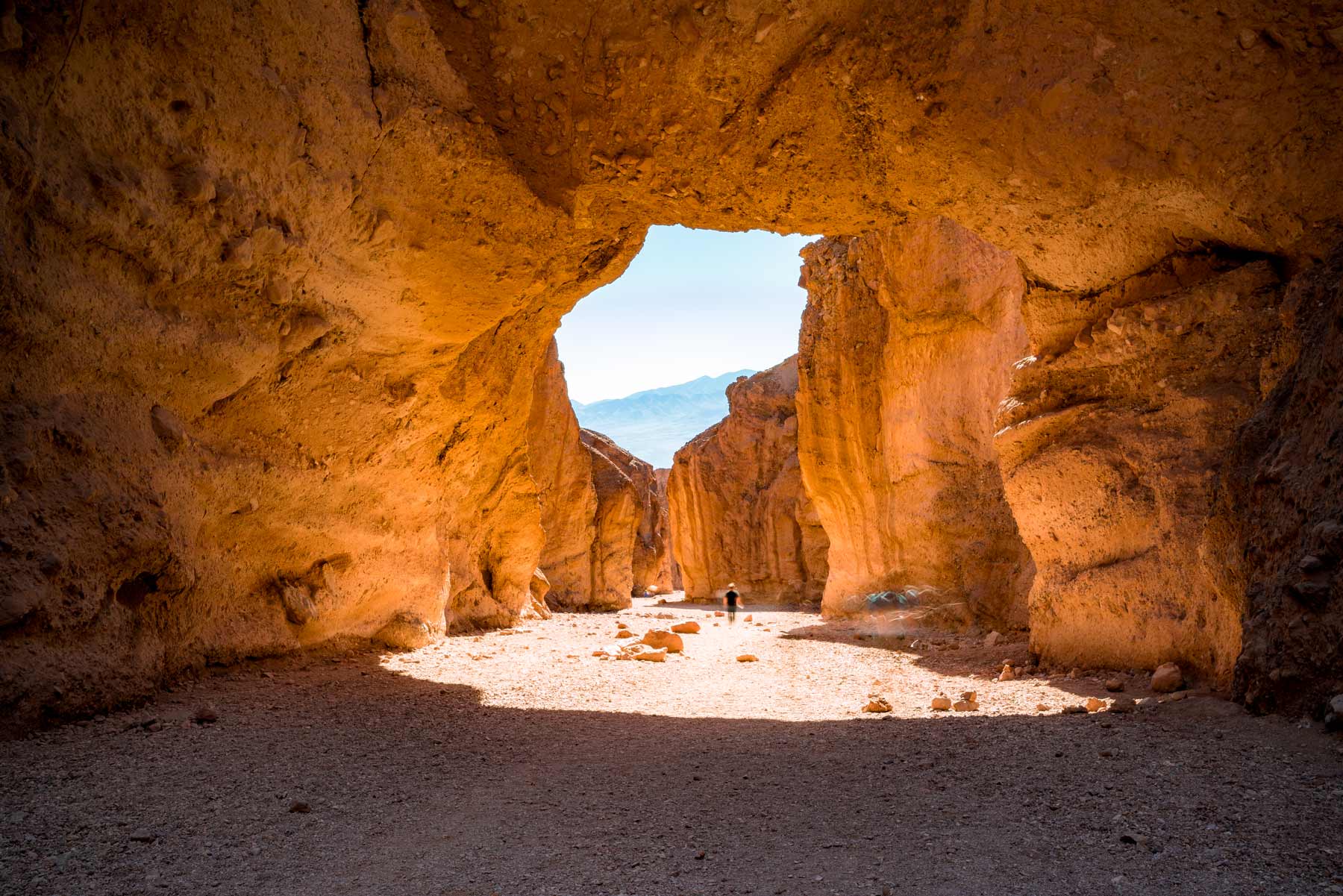
13. Walk Under Natural Bridge
Seeing Natural Bridge is a great activity at Death Valley to get out of the sun. The bridge itself is a 35-foot-tall and 35-foot-thick archway carved by flash floods over thousands of years. It’s a wild thought to imagine the powerful torrents of water rushing through ancient rock, slowly eroding it, that created this impressive bridge.
I really enjoy this hike and don’t find it too difficult but those with mobility issues may want to avoid it as the incline might be a bit much. This is a great day-time hike to avoid direct sun by walking on the shadowy side of the canyon (depending on the time of day).
- Distance: 2 miles round trip
- Time: 1-2 hours
The hike to the bridge is all uphill to the bridge and all downhill back to the parking lot, 1 mile each way. Once you get to the bridge the view back down the canyon is pretty cool giving one a great view of the valley in the distance.
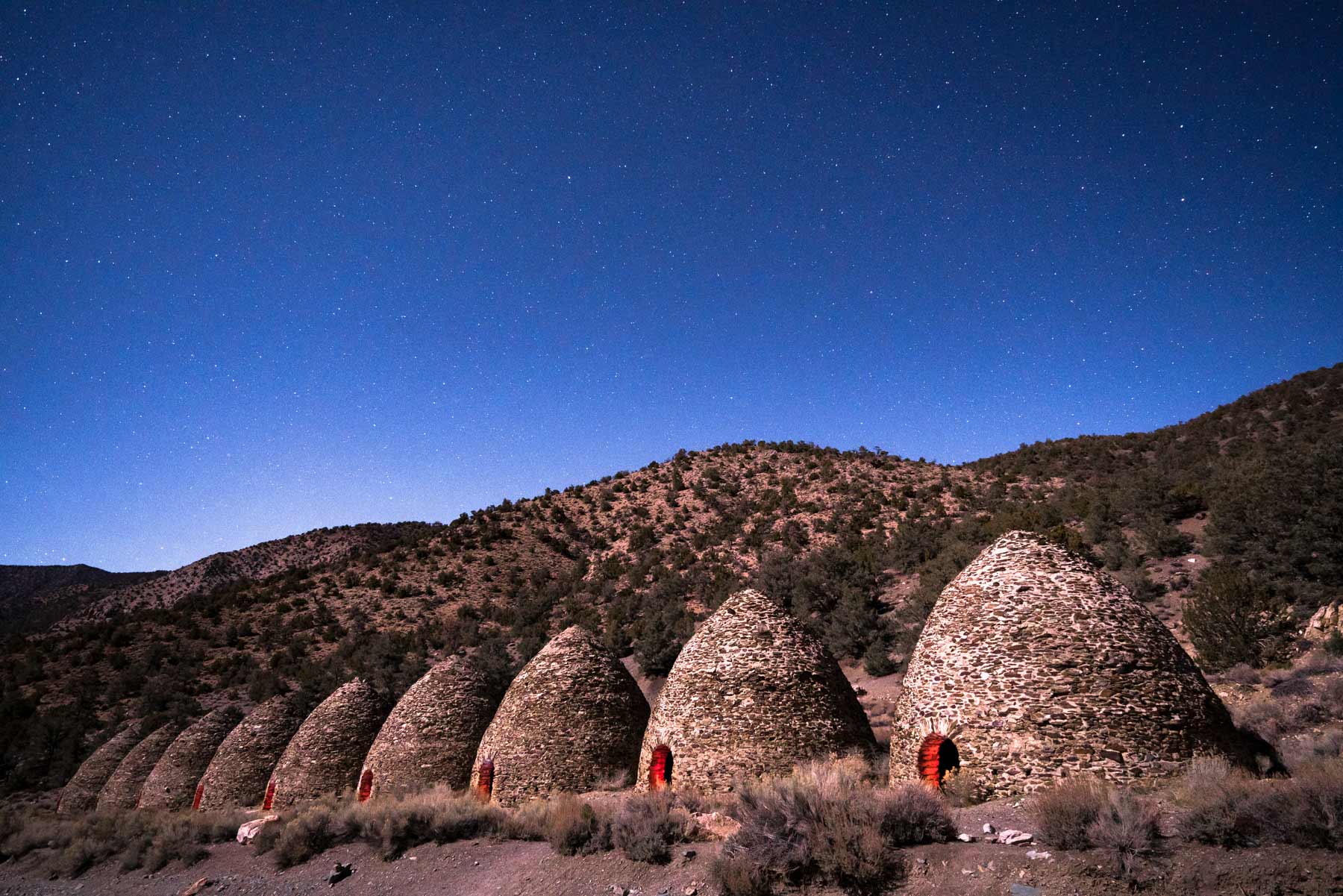
14. See the Wildrose Charcoal Kilns (by Night)
If you’re looking for interesting historic things to do at Death Valley National Park (at night) then add this one to your list! The Wildrose Charcoal Kilns is a cool spot to visit, easily mistaken for an abandoned village of windowless conical, beehive-shaped homes.
Built in 1877, the Wildrose Charcoal Kilns were constructed by the Modock Consolidated Mining Company to provide fuel for their silver and lead mines located about 25 miles west in the Argus Range. Back then, charcoal was a crucial fuel source for smelting metals, as it burned hotter and cleaner than wood.
These kilns were meticulously crafted from local stone and mortar, designed to efficiently convert wood into charcoal. Here’s how the process worked:
- Filling: Large quantities of pinyon pine logs, abundant in the surrounding hills, were meticulously stacked inside the kilns.
- Sealing: Once filled, the kilns were tightly sealed with mud and other materials to create an airtight environment.
- Burning: A controlled fire was ignited at the base of the kiln, triggering a slow and smoldering burn that could last for days.
- Cooling: After the burning process, the kilns were left to cool for several days to prevent spontaneous combustion.
- Harvesting: Finally, the cooled charcoal, a black, brittle substance, was extracted and transported to the smelters by pack animals or wagons.
I decided to visit the kilns at night under a waxing moon to try and grab a cool photo and was glad I did. The kilns are located in the Wildrose section of the park. The road leading to the Charcoal Kilns is notoriously bad and high-clearance vehicles are a MUST, if not 4WD.
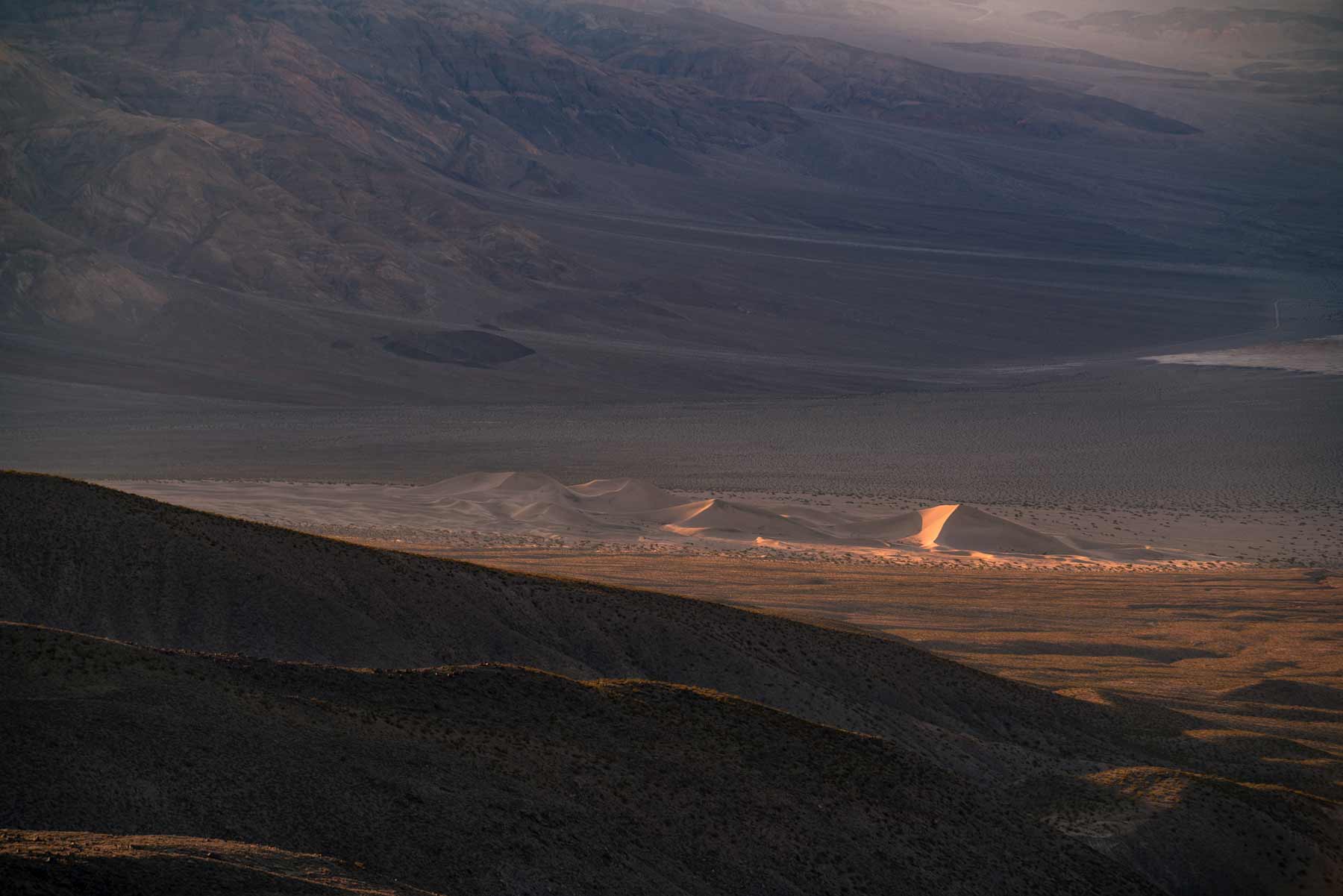
15. See Panamint Dunes (from afar)
Panamint Dunes are a lesser-traveled dune field in Death Valley National Park covering about 4 square miles that most visitors see from afar rather than actually visit themselves. The dune field is located in Panamint Valley and the trailhead for the dunes is accessed off of a long and rough dirt road.
The tallest of the Panamint Dunes reach around 200 feet high. This may seem small compared to the 400-foot giants of Mesquite Flat, or the 600+ foot tall dunes of Eureka, but it’s still an impressive figure, especially considering the surrounding desert landscape.
One of the things that sets the Panamint Dunes apart from the others in Death Valley is their unusual star-shaped formation, unlike the linear ridges found in other Death Valley dunes. This unique shape is attributed to the specific wind patterns that have sculpted them over time.
The hike to the dunes is a longer one at 7 miles round trip and should only be attempted during cooler temperatures as the heat can turn life-threatening in a hurry especially since these dunes are so remote.

16. Hike Through Surprise Canyon
If you’re looking for another unexpected activity then add Surprise Canyon to your list of things to do in Death Valley National Park. The aptly named Surprise Canyon is a real treat for park visitors featuring a lovely creek, some small waterfalls, and even burros! To get to the trailhead visitors must drive outside the park and then back up the canyon. As such, I’d say this is an activity to add to a longer stay or a second or third visit to Death Valley.
- Distance: 6.3 miles roundtrip
- Time: 3-4 hours
The hike itself is mostly uphill on the way up and mostly downhill on the way back. Every turn features new sites and adventures. Full disclosure, we witnessed a dead burro on this hike which is not uncommon so it might not be one of the best things to do in Death Valley National Park with kids.
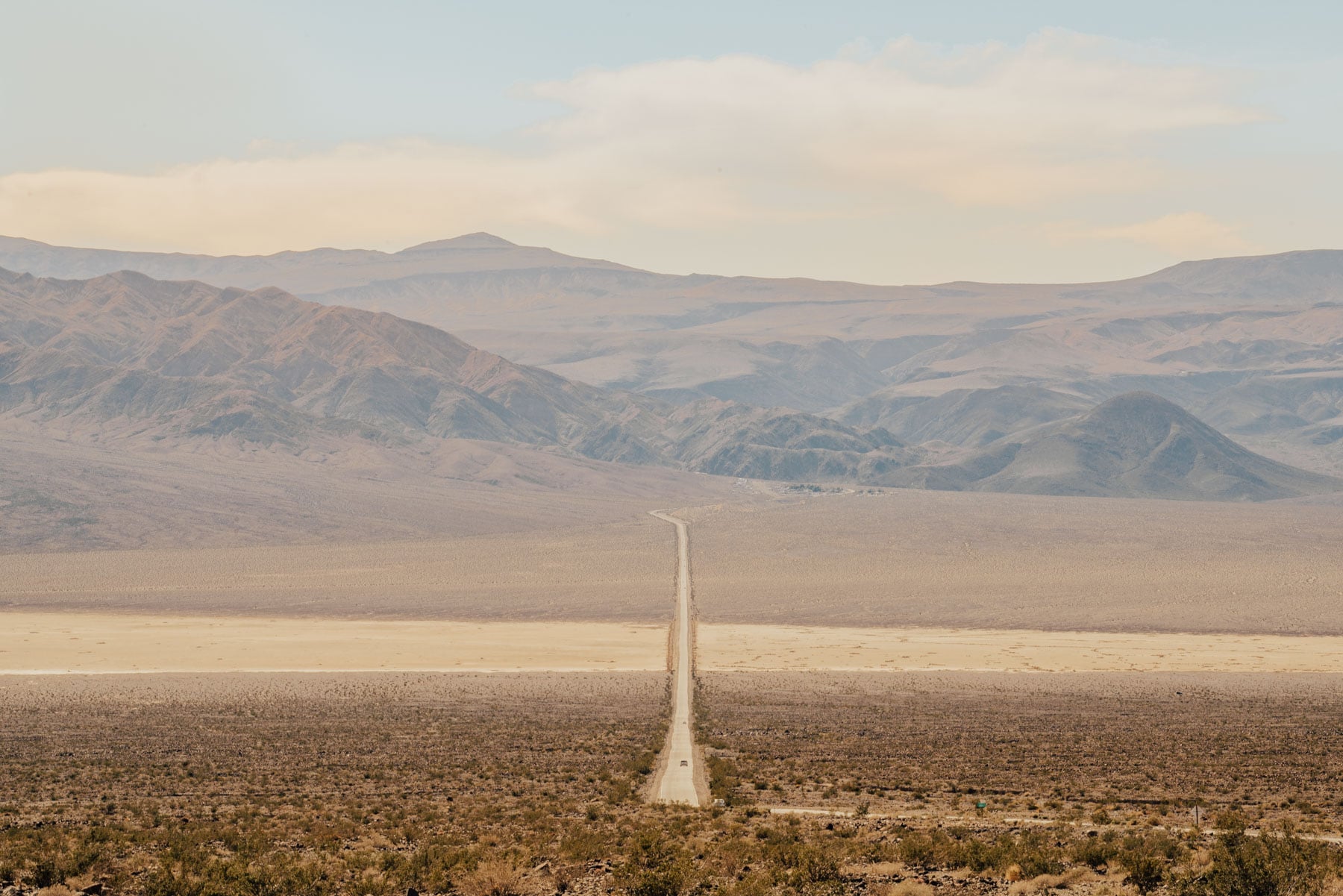
17. Take a Scenic Drive
A lot of folks don’t realize that Death Valley is the largest national park in the United States outside of Alaska. As such, there happens to be some very, very long drives throughout the park. In fact, there are over 1,000 miles of roads located within Death Valley National Park! Three hundred miles are paved, three hundred are improved, and the other six hundred are pretty much 4WD roads.
These drives can be split up between the ones that require 4WD and the ones that don’t. Regardless of whether you have 4WD capability, there are so many great roads to explore in the park. If you enjoy experiencing the park from the boundaries of the pavement inside of an air-conditioned vehicle then add this to your list of things to do in Death Valley National Park. A few of my favorite drives/stretches of road are:
- Highway 190
- Badwater Road
- Scotty’s Castle Road
- Eureka Road
Driving Tips in Death Valley
Make sure you have a good spare tire if you’re heading off-road and have a plan in case you break down. Service is spotty at best throughout the park and it can be a very long time before someone else comes across your vehicle. Pack way more food & water than you think you’ll need. If you break down somewhere on a dirt road it could be hours or days before someone finds you.

18. Ascend Telescope Peak
Elevation: 11,049ft
Telescope Peak is the highest point in Death Valley National Park and is regularly snow-capped! I never thought I would see snow in Death Valley so this was a real shocker for me! Beyond the snow, there’s much that’s different about this area. As you ascend up Charcoal Kiln Road to the trailhead, you’ll notice pinyon pines and junipers – quite a difference from the valley floor! Keep an eye out for the ancient bristlecone pines, some of the oldest living organisms on Earth.
For those interested in hiking, be prepared for a hearty trek. The Telescope Peak Trail is an out-and-back route spanning roughly 14 miles with an elevation gain of around 3,200 feet. It’s considered a strenuous hike due to the steep incline, loose scree, and high altitude. Be prepared for a physically demanding journey that will take between 5 and 7 hours to complete.
One of the best places to see the sunrise over Telescope Peak is just past the Lee Flat Joshua Tree Forest off Hunter Mountain Road (more on this coming up). Add this to your list of things to do in Death Valley if you’re looking for an unexpected experience.
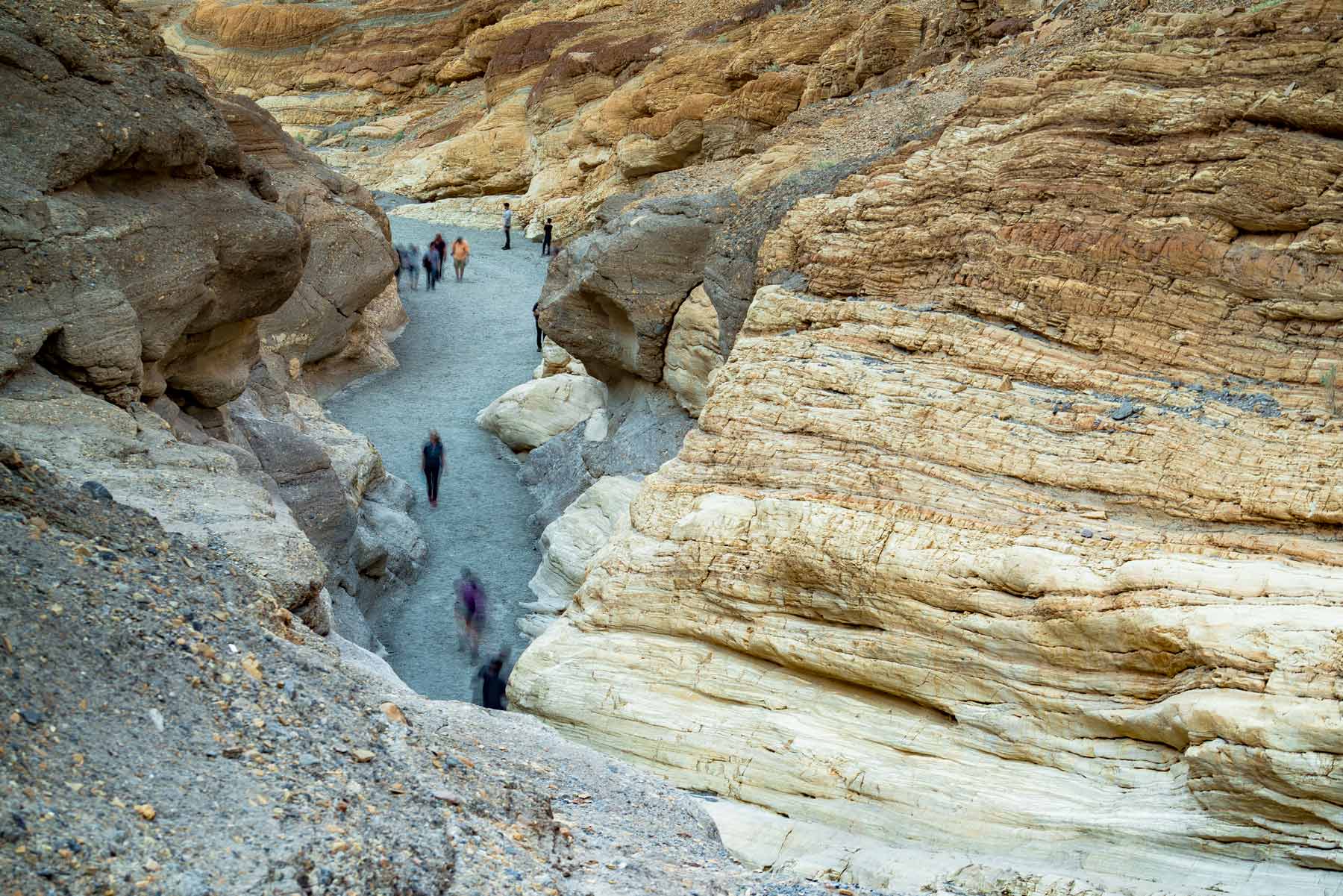
19. Marble Canyon
The hike through Marble Canyon is a great daytime activity in Death Valley on a hot day (so long as you’re prepared) as there is typically ample shade and cooler places to rest. This hike is a short and cool jaunt winding through Marble Canyon with some fairly narrow passageways.
The canyon walls are composed of colorful marble (thus the name), ranging from white and green to pink and purple. These vibrant hues are a result of various minerals, including iron oxide and manganese.
The entire trail is extremely long at about 31 miles so I recommend just walking a mile or two into the canyon and then picking a point to turn around. Make sure to pack plenty of water for the hike as even though there’s shade, the extreme temperatures are not to be messed with here.
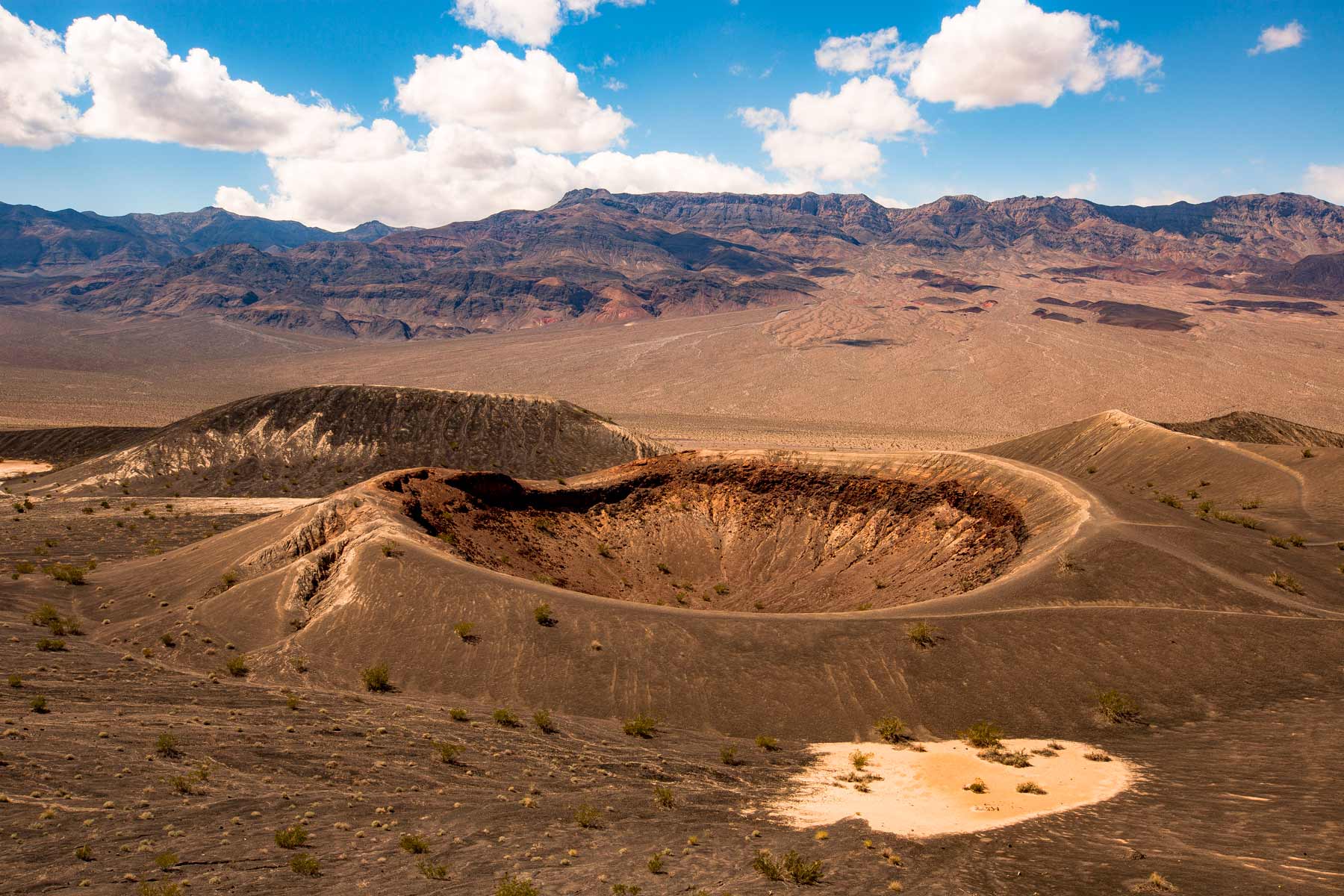
20. Explore Little Hebe Crater
A lot of folks don’t even know that Ubehebe Crater has a sibling – Little Hebe Crater – so it often gets totally overlooked on lists of things to do in Death Valley. Personally, I find the junior to be the more interesting of the Ubehebe craters.
With a diameter of around 400 feet and a depth of about 150 feet, Little Hebe is significantly smaller than Ubehebe. Despite its size, it still packs a punch in terms of geological significance. Unlike Ubehebe’s maar origin (formed by a phreatic explosion), Little Hebe is a spatter cone, built up by the accumulation of ejected lava fragments during eruptions.
To get to Little Hebe Crater start at the parking lot for Ubehebe and follow the rim trail to the right. Eventually, you’ll find a turnoff for Little Hebe which is less than a mile walk on a nice path. An easy addition to your list of things to do in Death Valley, I think Little Hebe is the more photogenic of the two and totally worth the extra steps.
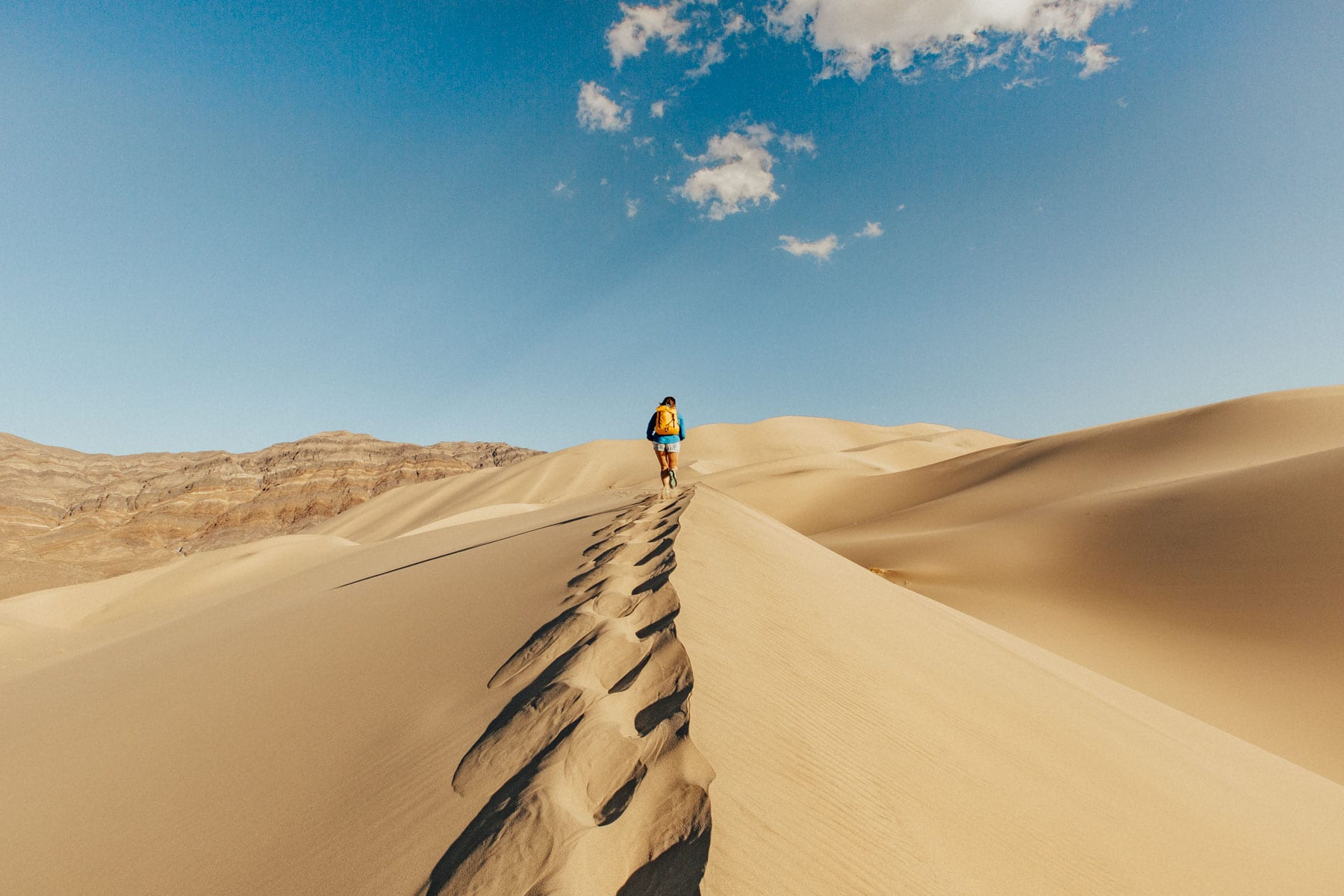
21. Venture Out to Saline Valley Dunes
If you’re looking for some of the more isolated things to do at Death Valley National Park, Saline Valley dunes are perhaps the most remote in the park. Spanning a larger area than Mesquite Flat, the Saline Valley Dunes consist of gently rolling waves of sand, creating a mesmerizing visual expanse. Reaching a maximum height of around 100 feet, the Saline Valley Dunes offer a more approachable and less physically demanding exploration.
Located in Saline Valley, these dunes are beautiful but probably the least striking of all the dune fields in the park. Death Valley actually has 5 separate dune fields to choose from and these are probably at the bottom of that list for me. My favorite are the Eureka Dunes located on the north end of the park.
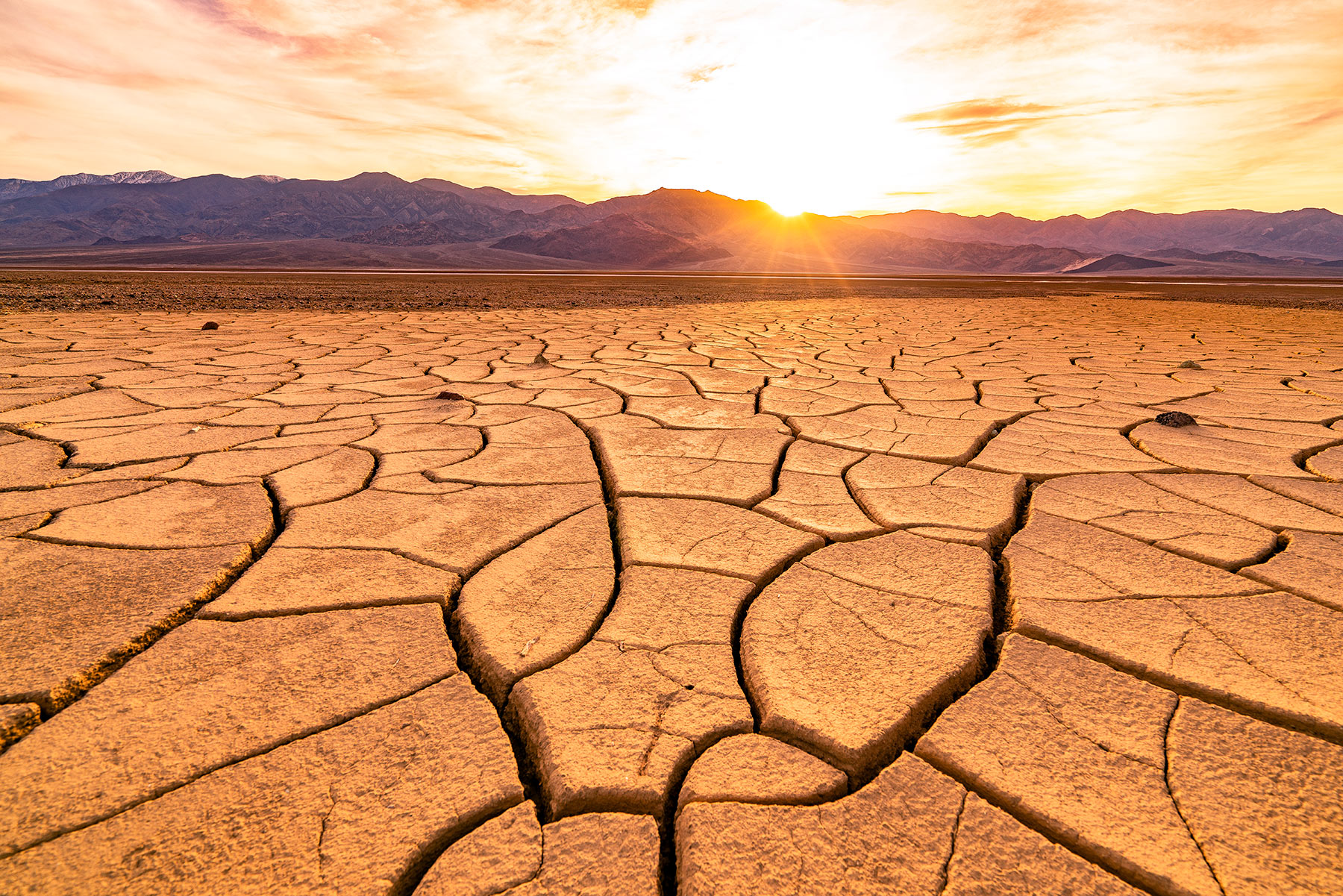
22. Find the Famous Death Valley Mud Cracks
Finding the best mud cracks was high on my list of things to do at Death Valley National Park as the photos I’d seen before visiting seemed almost fake. Death Valley is famous for scenes like the one above – a valley floor beautifully cracked with beautiful, geometric shapes. There are many places all over the valley where different shapes, colors, and sizes of mud cracks can be found.
Where I Found the Best Mud Cracks in Death Valley
People are very protective of these places and out of respect to the park I won’t say exactly where I found my favorite ones. I can say that driving down Badwater Road south of Furnace Creek there are lots of great spots. Check out the photos you see and try to match them with the mountains and topography.
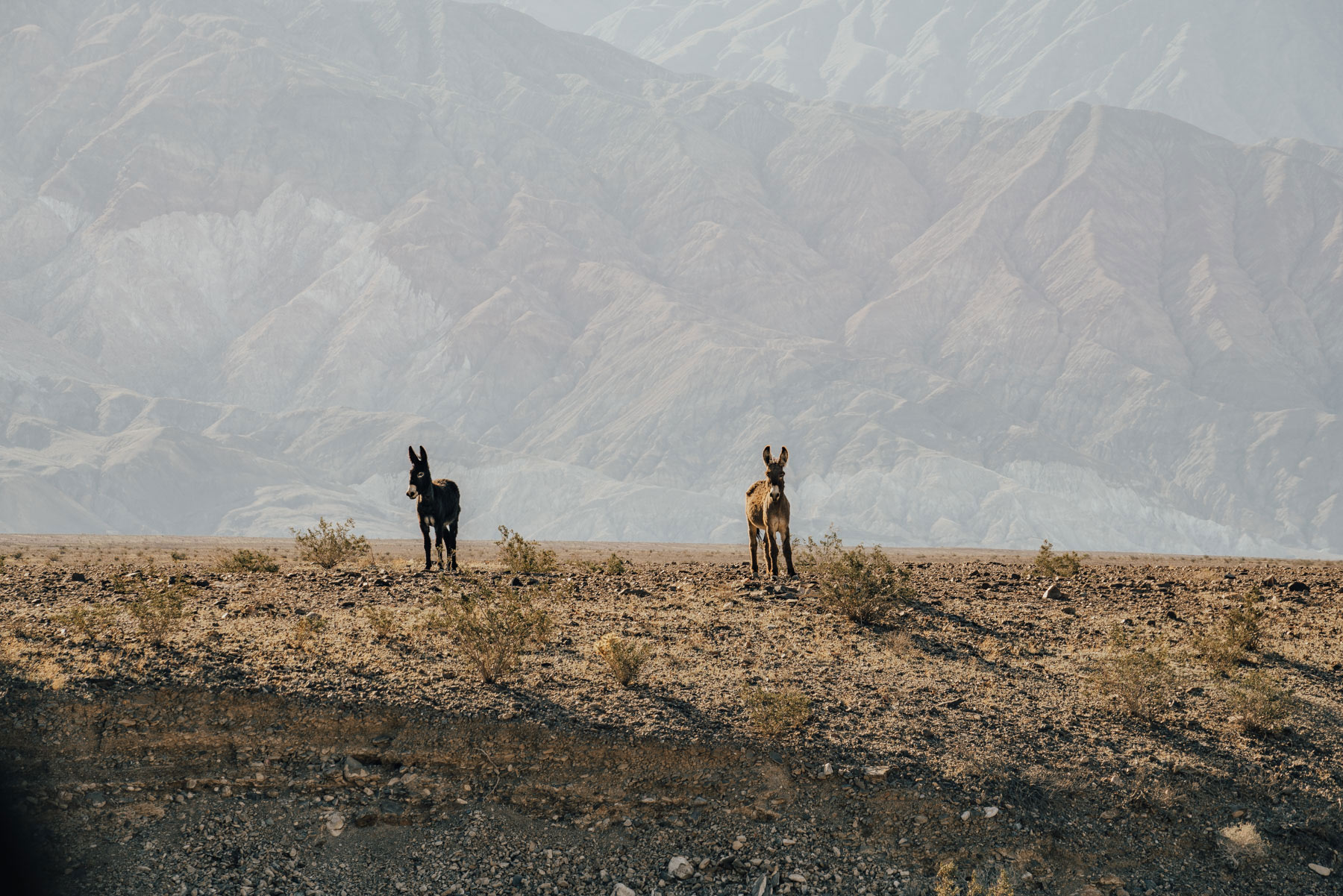
23. Find Death Valley’s Elusive Burros
This is one of those things to do in Death Valley that probably won’t be around for much longer. Imported by miners during the 19th century, burros are actually an invasive species to the National Park and disrupt the natural ecosystem here. As such the park service is actively working to reduce/remove the current population in the park.
Eventually, these feral donkeys will be completely removed. Until then, they’re pretty cool to spot in the park. We saw several in Surprise Canyon and near the Wildrose area. Drive slow and keep a keen eye out and there’s a good chance you’ll see some!
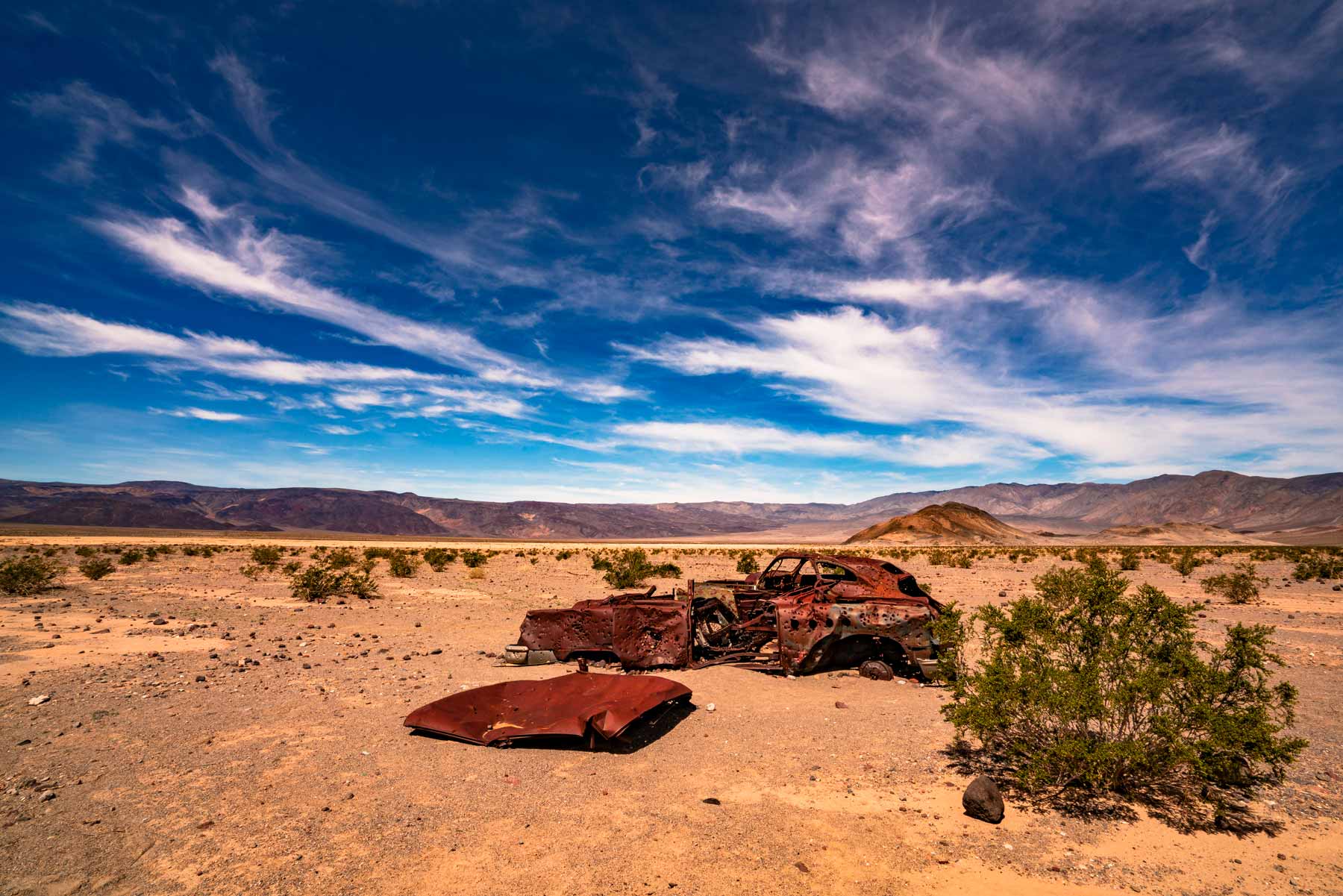
24. Find Abandoned Historical Remnants
If rusty old abandoned cars are your thing then add this one to your list of things to do in Death Valley. Death Valley National Park is chocked full of abandoned remnants of bygone eras in the land’s history. You can find all sorts of interesting artifacts here from abandoned cars to mining equipment, tunnels (do not enter these), and more.
You are legally required to leave these objects and artifacts just as you found them. Please resist the temptation to take any of these things from the park or move them from their current positions. A couple of good spots to see historical remnants include:
- Ibex Dunes (an old mining tower)
- Panamint Dunes Road (rusty cars)
- Wildrose Road (charcoal kilns)
- Aguereberry Point Road (Eureka Mine)
- Harmony Borax Works
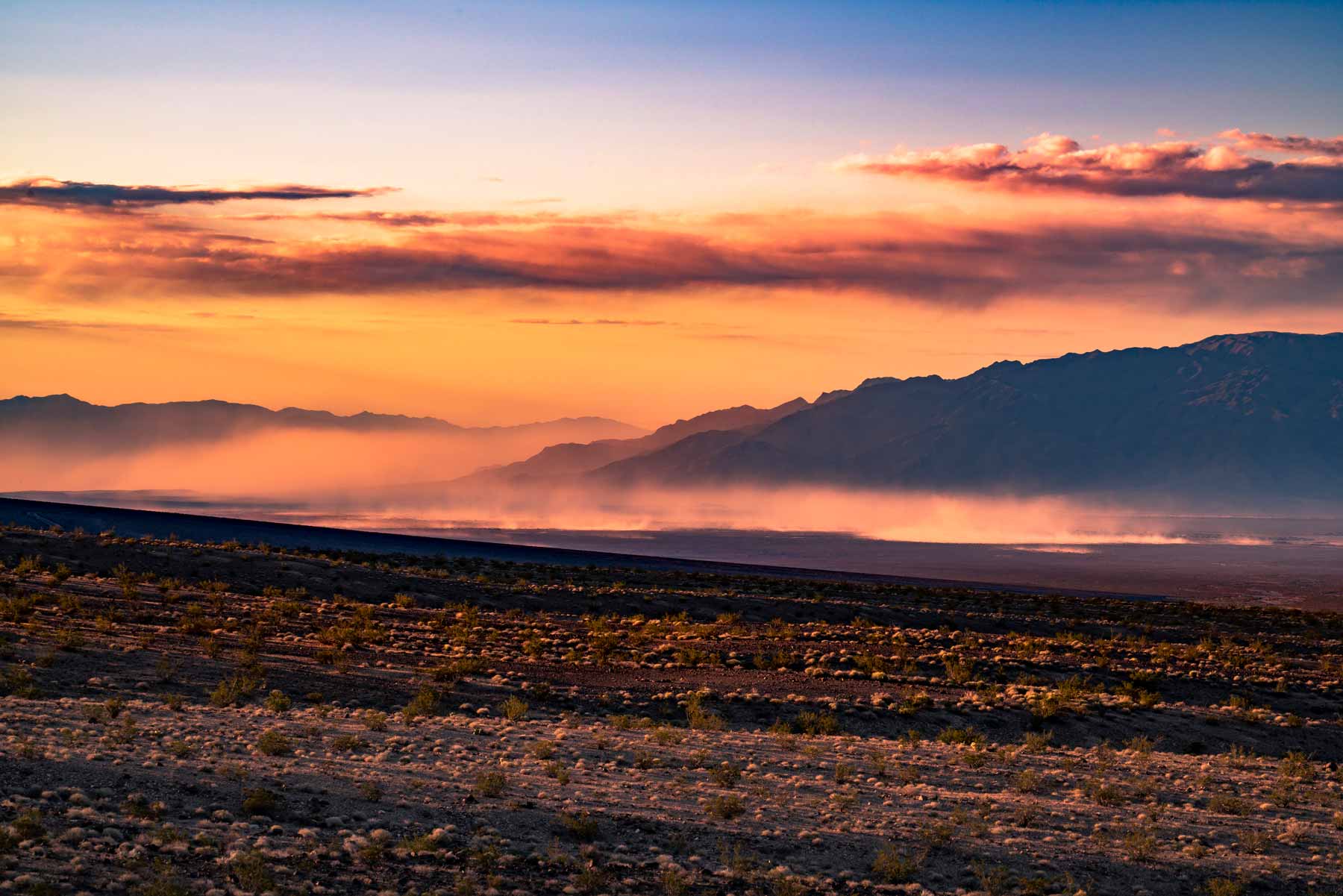
25. Witness Sandstorms (from afar!)
One of the coolest and most mesmerizing things to do in Death Valley is watching a sandstorm move across the desert (especially during magic hour). I was lucky enough to witness one of these on my last trip to Death Valley and was amazed by the experience. The way the light illuminated the sand as it hurdled across the valley floor was spectacular.
I waited too long to get into the car and boy did it sting when it came in close! Make sure to take cover if you see one of these approaching. High winds can sometimes pick up in the valley seemingly out of nowhere. When this happens seek higher ground and you just might get lucky enough to spectate from above.
FAQ – Things to Do in Death Valley
Some of the best things to do at Death Valley are: see Eureka Dunes, explore Mesquite Flat Dunes, hike into Badwater Basin, sunrise at Zabriskie Point, discover Darwin Falls, see Lee Flat Joshua Tree Forest.
Iconic Views: Zabriskie Point, Dante’s View, Badwater Basin (lowest point in North America)
Geological Wonders: Artist’s Palette, Mesquite Flat Sand Dunes, Mosaic Canyon, Natural Bridge
Unique Features: Racetrack Playa (mysterious moving rocks), Salt Flats, Scotty’s Castle
Hiking: Trails for all levels, from short overlooks to challenging treks
Stargazing: Unforgettable night skies due to minimal light pollution
Photography: Capture stunning landscapes, colorful rock formations, and desert wildlife
Sandboarding: Mesquite Flat Dunes and Eureka Dunes offer thrilling slopes
Exploring ghost towns: Remnants of Death Valley’s mining history
Fall (October-November) and spring (March-May) offer pleasant temperatures, but be prepared for crowds. Winter (December-February) boasts sunny days and fewer crowds, but nights can be chilly. Summer (June-September) is brutally hot, limiting outdoor activities.
Map of Things to Do in Death Valley
Summary of the Top 10 Things To Do in Death Valley National Park
- Eureka Dunes
- Badwater Basin
- Zabriskie Point
- Racetrack Playa
- Artists Palette
- Mesquite Flat Dunes
- Lee Flat Joshua Tree Forest
- Ubehebe Crater
- Darwin Falls
- Aguereberry Point
- Devils Golf Course
- Ibex Dunes
- Scenic Drive
- Sandstorm
- Burros
- Telescope Peak
- Surprise Canyon
- Panamint Dunes
- Charcoal Kilns
- Natural Bridge
- Mud Cracks
- Saline Valley Dunes
- Little Ubehebe Crater
- Abandoned Remnants
- Marble Canyon

Visiting Death Valley National Park
There are many ways to get to Death Valley National Park. One of the most popular is flying into Las Vegas and making the 2-hour drive to the park. The second closest major city is Los Angeles 4 hours away.
Four-Wheel Drive: Four-wheel drive isn’t an absolute *must* in but it sure opens up your options as to the things you can see. I’d recommend renting a 4WD vehicle but you’ll be able to see plenty of amazing things without one. Check out this helpful article for the best places to see in Death Valley with 4WD.
The Award-Winning Death Valley Video
We created this 3-minute video based on our travels to Death Valley. It won some awards and was even featured by National Geographic. If you’re planning a trip to the park we encourage you to take a few minutes and watch our film. To make this film we spent weeks in the national park, mostly in February and March when the temperatures are more manageable. We traversed hundreds of miles hiking most of the park’s trails to capture the park like never before.
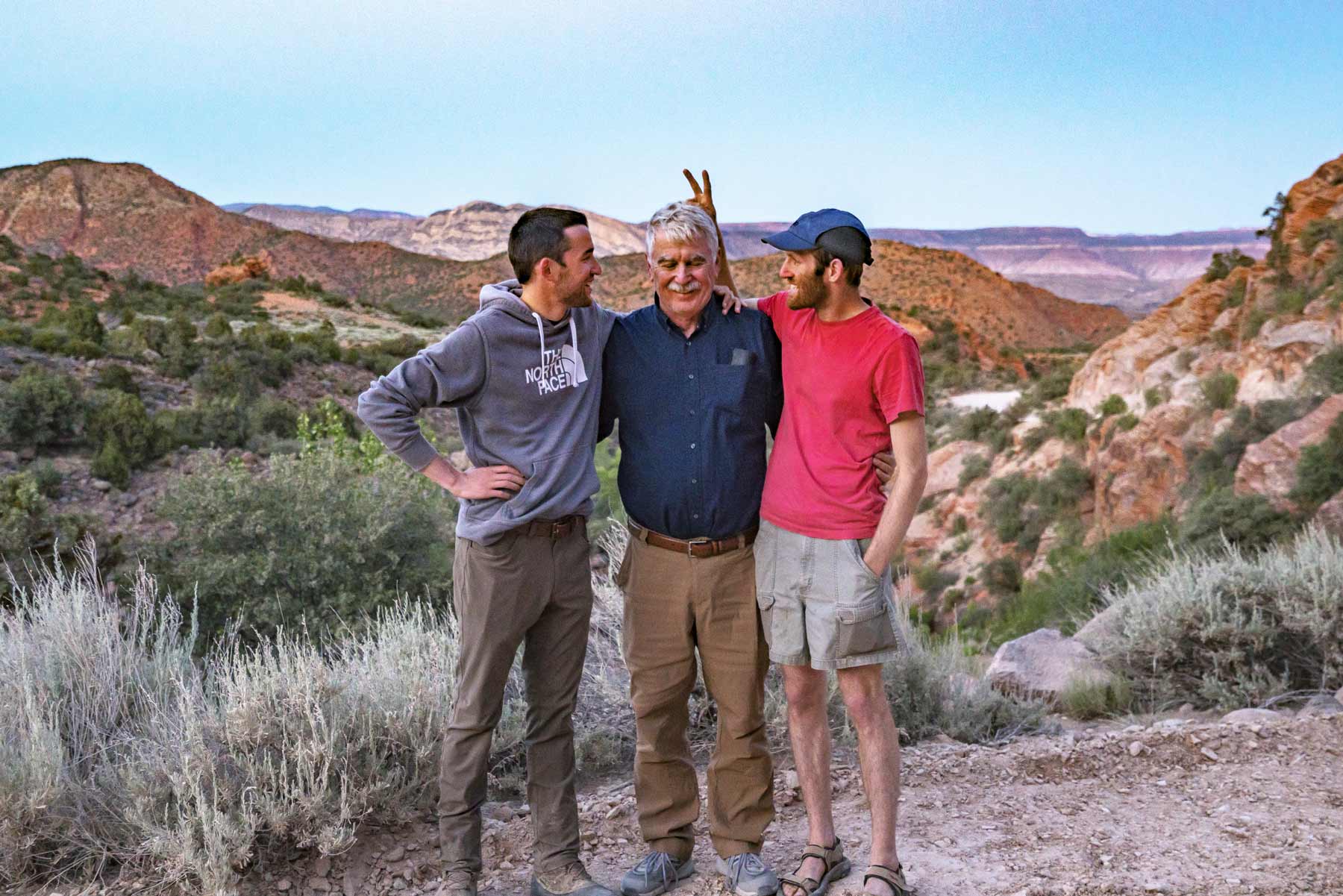
My Travels to Death Valley National Park
I visited Death Valley National Park for the first time on a whim in 2008 while on a road trip with friends. It was during the winter months and we found ourselves amazed by the heat (the park averages 80° in the dead of winter).
Since then I’ve returned scores of times because I simply can’t get enough. There is something seriously magical about this desert wonderland that I cannot resist. Make no mistake, a lot of our national parks are otherworldly but this one takes the cake.
Death Valley National Park Map
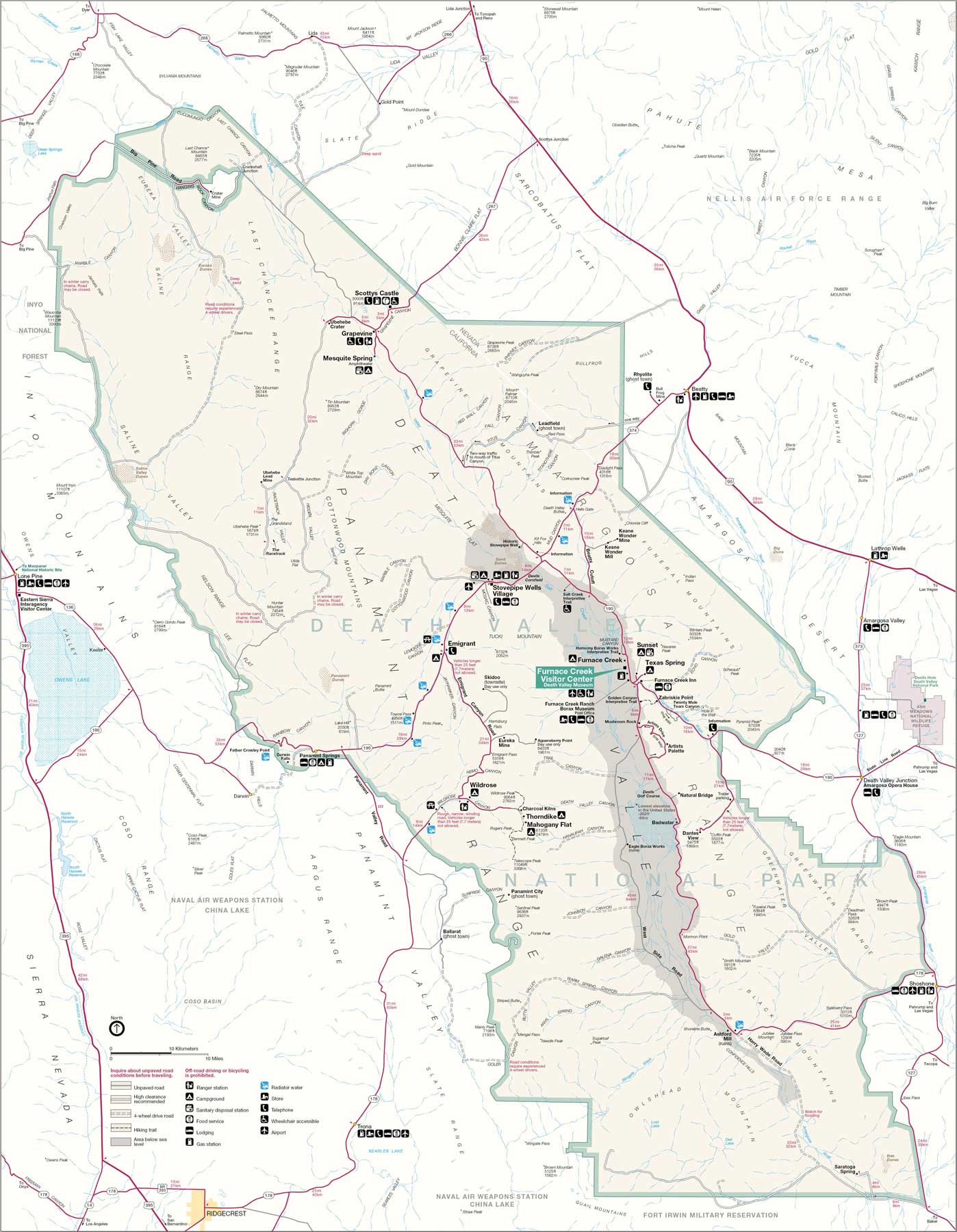
Pin Things to Do in Death Valley
Click for Pins!
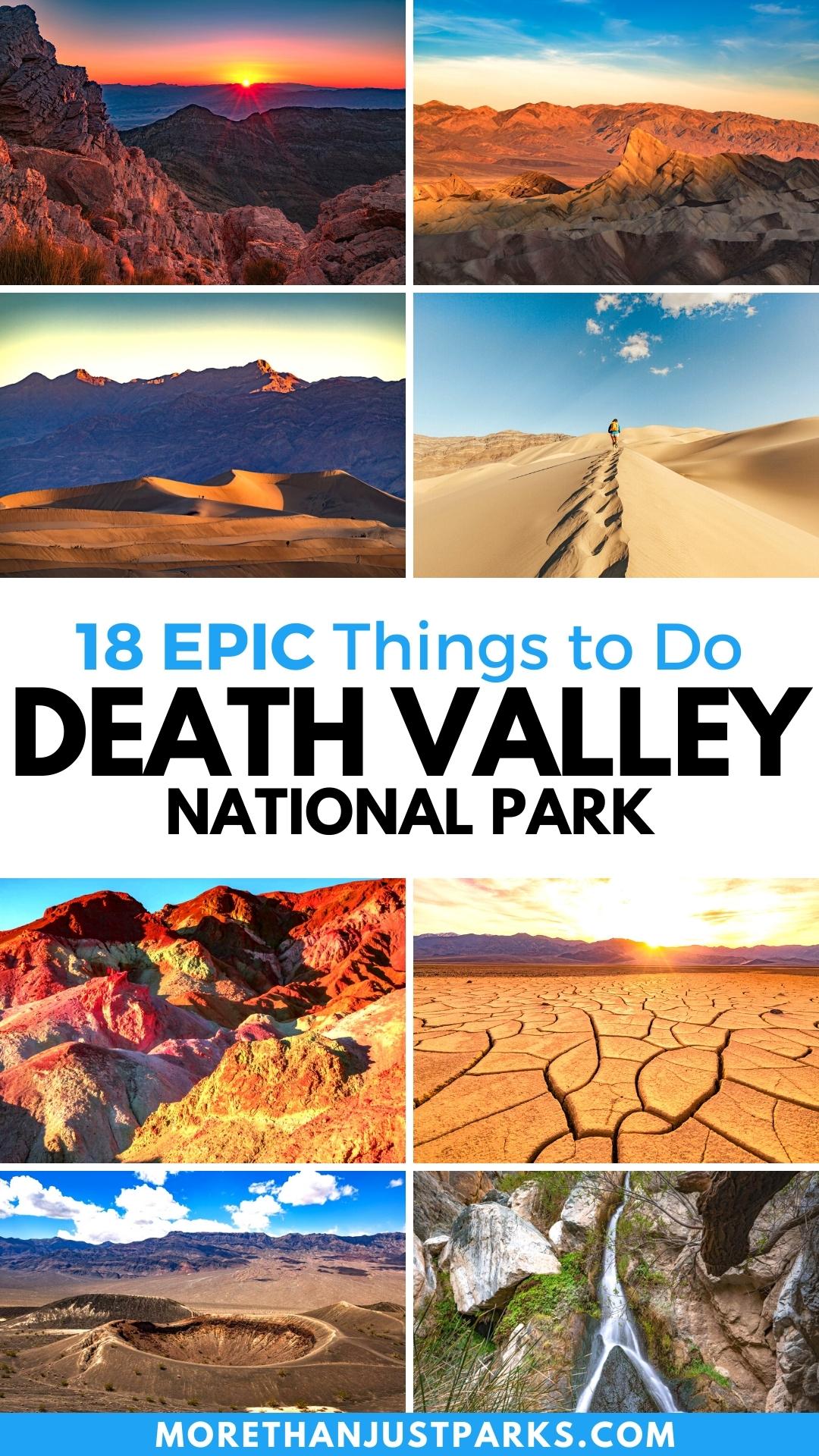


More From Death Valley
- Death Valley National Park Guide: Death Valley National Park Ultimate Guide
- Facts About Death Valley: 15 Fascinating Facts About Death Valley National Park
- Death Valley by Season: Spring | Summer | Fall | Winter
- Death Valley Camping: 9 Best Campgrounds in Death Valley
- Eureka Dunes: Visiting Eureka Dunes in Death Valley
More From California
- Joshua Tree Guide: Joshua Tree National Park Ultimate Guide
- Best Hikes Joshua Tree: 15 Epic Hikes in Joshua Tree National Park
- Things to Do Joshua Tree: 25 Epic Things to Do at Joshua Tree National Park
- Things to Do Sequoia: 15 Epic Things to Do at Sequoia National Park
- Redwood National Park Guide: Redwood National Park Ultimate Guide
- Things to Do Redwood National Park: 15 EPIC Things to Do in Redwood National Park
- Things to Do Pinnacles National Park: 10 Epic Things to Do in Pinnacles National Park
- Redwoods Near San Francisco: 15 BEST Places to See Redwoods Near San Francisco
- Los Angeles National Parks: 7 Epic National Parks Near Los Angeles
- San Francisco National Parks: 8 BEST National Parks Near San Francisco
- San Diego National Parks: 6 AMAZING National Parks Near San Diego
- Yosemite Facts: 10 Shocking Yosemite National Park Facts
- Sequoia Facts: 10 GIANT Sequoia Tree & National Park Facts
- West Coast Parks: 20 BEST West Coast National Parks Ranked by Experts
- National Parks Near Las Vegas: 6 Best National Parks Near Las Vegas

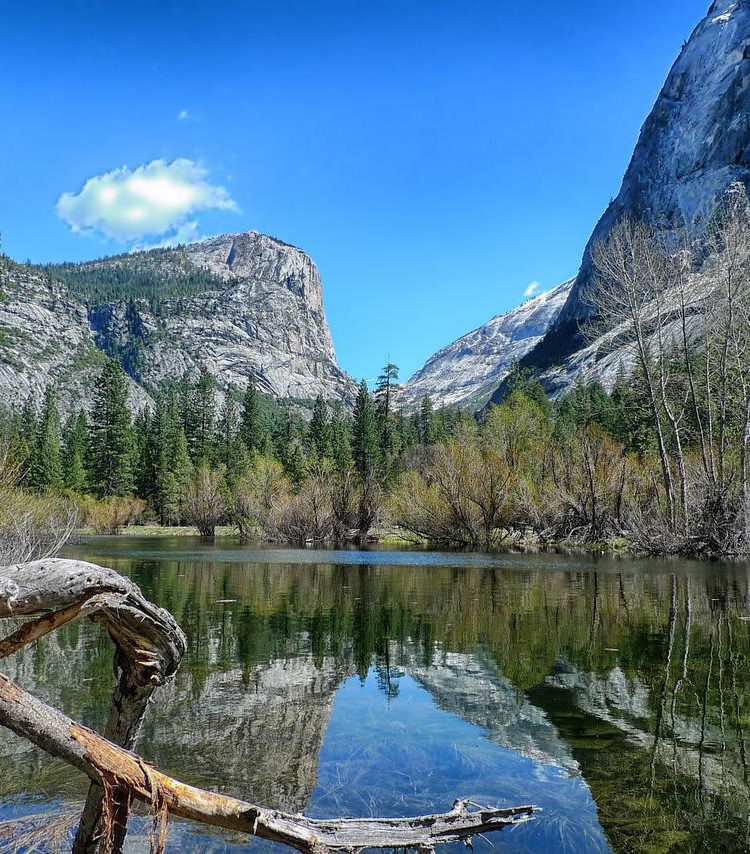
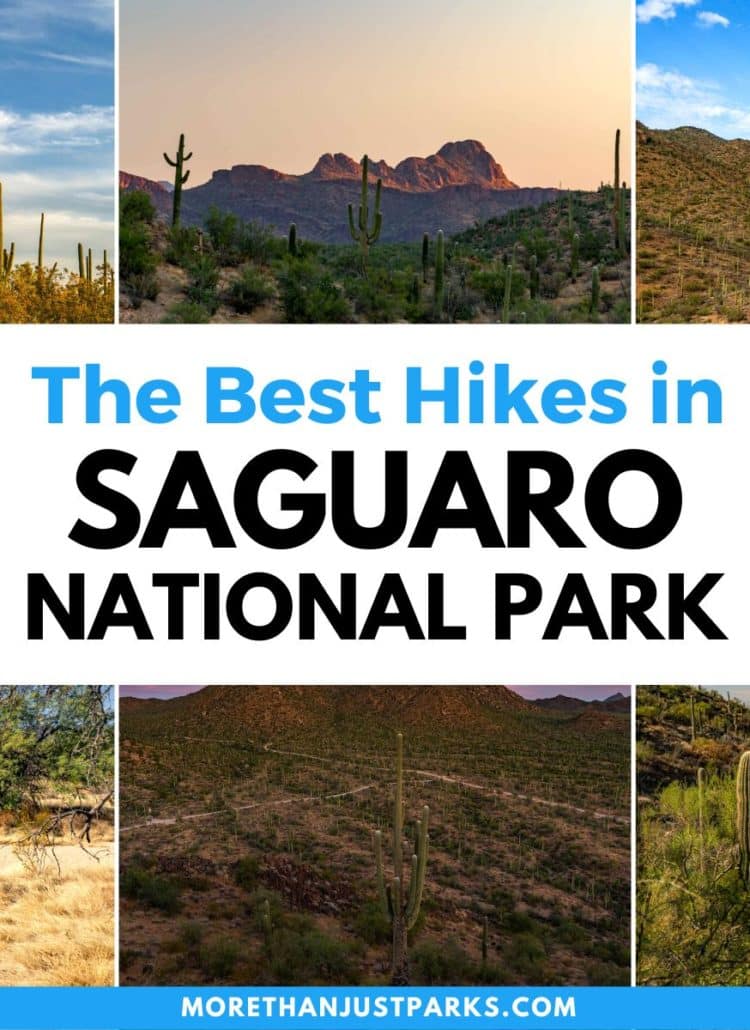
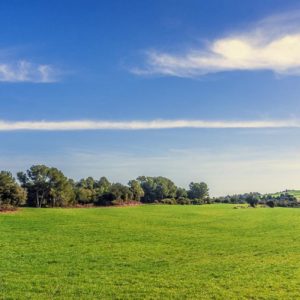

Absolutely love to see a PROPER guide, made as it should be. Not just 3 photos for instagram and 0 help.
Great work!
fantastic article and photos! would love suggestions on where to stay (towns, that is) outside the park in order to cover as much territory as possible.
This is a great guide. I love to go off roading in Death Valley. I’m always discovering new and beautiful spots.
I think it is very cool that there are sometimes a big wildflower bloom.